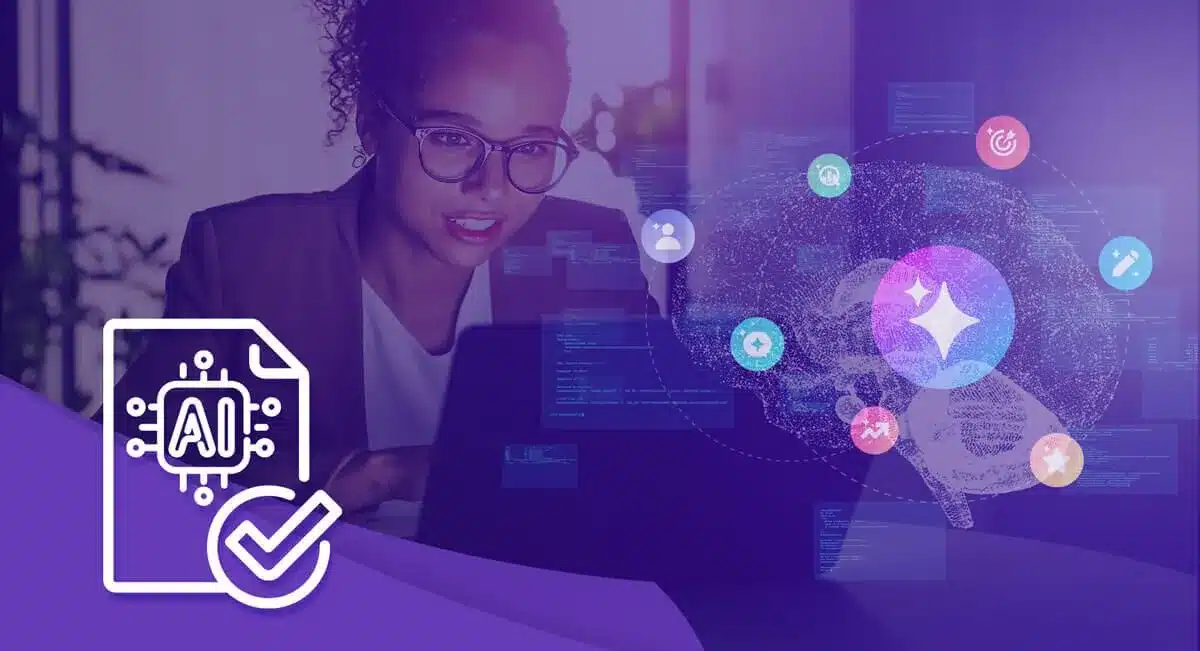A recent Forbes study projects that the AI market will soar to $1,339 billion by 2030. AI adoption is no longer a trend—it’s a necessity across industries.
The days when AI was merely a futuristic concept are long gone. For digital marketers, failing to leverage AI means falling behind and missing out on enhanced efficiency, hyper-personalization, and data-driven insights that can transform campaigns and drive success.
AI has already revolutionized the way we create content, engage with customers, generate leads, and analyze data. From intelligent automation to hyper-personalized experiences, AI empowers you to work smarter, not harder. Whether it’s chatbots handling customer inquiries, AI-driven SEO optimizing content, or predictive analytics refining ad strategies, the impact of AI is undeniable.
This AI cheat sheet is your go-to resource for leveraging your AI marketing strategy. We’ll break down the essential concepts, tools, and step-by-step strategies that agencies and brands can use to automate workflows, optimize campaigns, and personalize marketing efforts at scale.
Whether you’re a seasoned marketer or just starting to explore AI-driven solutions, this guide will equip you with the knowledge you need to stay ahead of the curve in 2025.
Automate every step of the customer journey with AI employees
What is AI?
Artificial Intelligence (AI) might sound like something out of a sci-fi movie, but in reality, it’s already shaping the world around us—including how we market products and engage with customers.
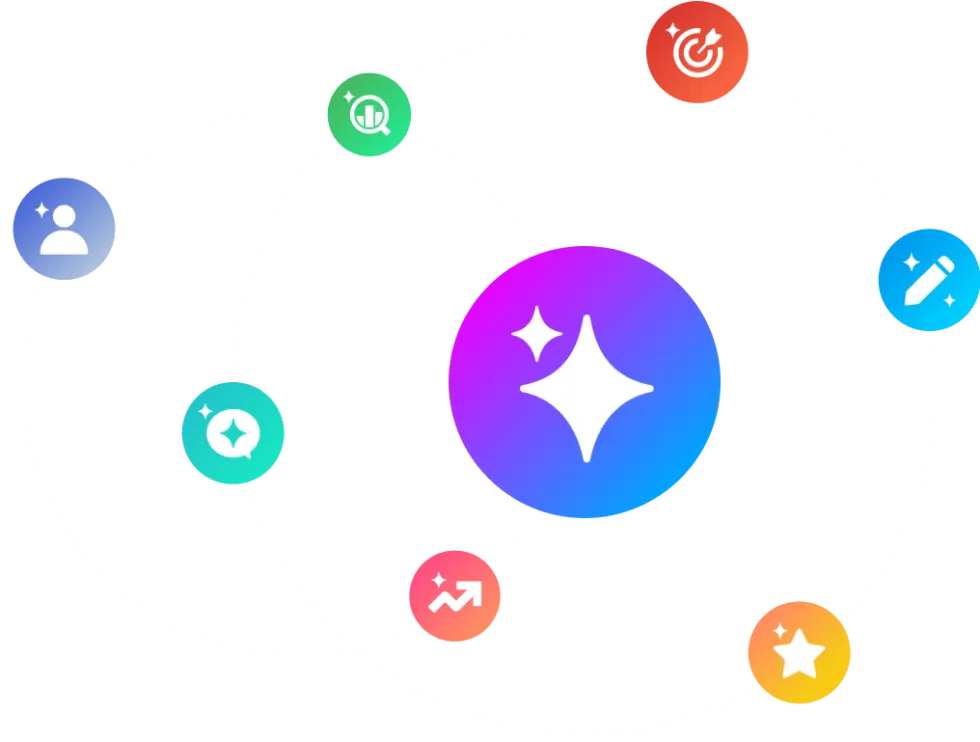
At its core, AI is a technology that mimics human intelligence—it learns from data, solves problems, understands language, and even makes decisions. Think of it as a digital brain that processes information at lightning speed to help businesses work smarter.
Unlike traditional software that follows strict programming rules, AI software adapts, predicts, and improves over time, making it a game-changer for digital marketing.
Why Marketers Should Care
If you’re a digital marketer, AI isn’t just helpful—it’s essential. Why? Because it allows you to:
- Automate repetitive tasks: Say goodbye to manual client reporting, email scheduling, and A/B testing.
- Deliver hyper-personalized experiences: AI analyzes user behavior and serves the right content, ads, and emails at the right time.
- Make smarter data-driven decisions: Predict customer trends, optimize campaigns, and adjust strategies in real-time.
AI-Powered Marketing is Already Everywhere
Even if you haven’t actively embraced AI yet, chances are you’re already benefiting from it:
- Google & Meta Ads: AI determines the best audience, bidding strategy, and placements for your ads.
- Chatbots & Virtual Assistants: AI chatbots provide 24/7 customer support and answer queries instantly.
- Predictive Analytics: AI forecasts trends, helping marketers anticipate customer needs before they even arise.
- Automated Email Marketing: AI optimizes subject lines, send times, and content for maximum engagement.
And that’s just the beginning! AI is the silent force behind many of the marketing tools you use daily.
So, the real question isn’t whether you should use AI in marketing—it’s how to maximize its potential. Let’s dive into the ultimate AI cheat sheet and get you up to speed.
Key AI Concepts and Their Marketing Applications
Here’s a breakdown of the key AI concepts and how your agency can leverage them to boost marketing performance.
1. Machine Learning (ML)
Machine Learning (ML) is a branch of AI that enables systems to learn from data and improve their performance over time without being explicitly programmed. It identifies patterns, makes predictions, and refines decision-making based on real-world interactions.
Example
Google’s RankBrain: One of Google’s AI-driven algorithms that refines search rankings based on user behavior and engagement. When people interact with search results, RankBrain learns which results are most relevant and adjusts rankings accordingly.
How Agencies Can Use It
- SEO Optimization: Machine learning helps refine search strategies by analyzing ranking trends, user intent, and content effectiveness. AI-powered tools like Clearscope or SurferSEO suggest keyword optimizations based on ML insights.
- Predictive Lead Scoring: ML analyzes customer data to predict which leads are most likely to convert, helping sales teams focus on high-potential prospects.
- Automated Ad Targeting: Platforms like Google Ads and Facebook Ads use ML to optimize ad delivery, ensuring your ads reach the right audience at the right time for better ROI.
2. Natural Language Processing (NLP)
Natural Language Processing (NLP) is AI’s ability to understand, interpret, and generate human language. This enables machines to process text and speech, making interactions more natural and intelligent.
Example
- AI-powered chatbots: Companies use NLP-driven chatbots like Vendasta’s AI-assisted web chatbot, Drift, or Intercom to interpret customer inquiries, respond intelligently, and even escalate complex queries to human agents when necessary.
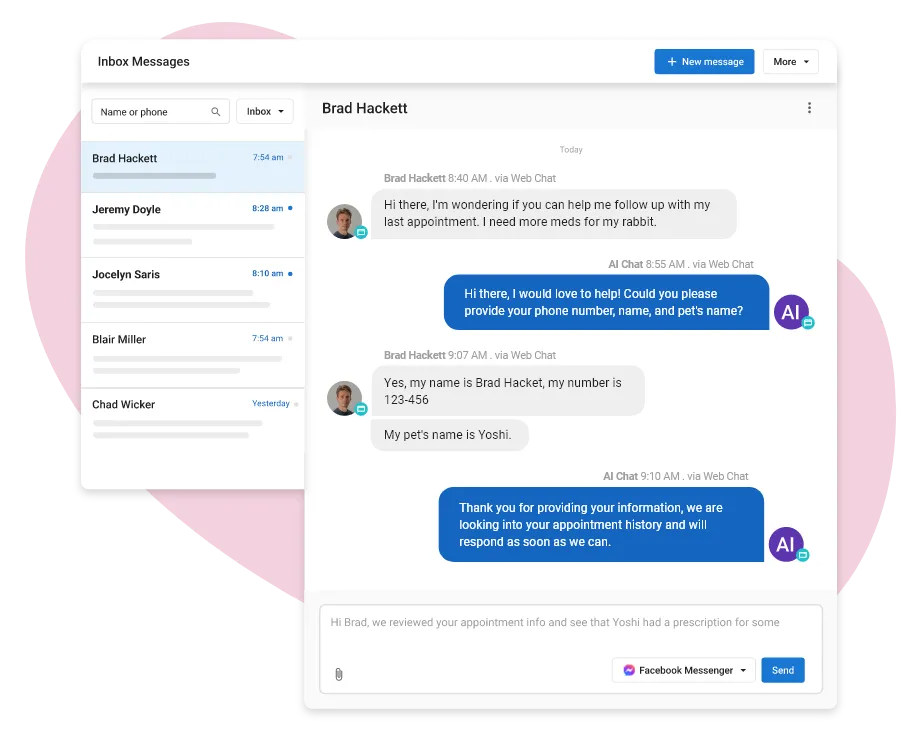
How Agencies Can Use It
- Sentiment Analysis: NLP can analyze customer feedback, reviews, and social media mentions to determine sentiment (positive, neutral, or negative), helping brands adjust messaging accordingly.
- AI-Powered Review Responses: Tools like Vendasta’s AI review responder generate personalized and appropriate responses to customer reviews, maintaining engagement and reputation.
- Voice Search Optimization: NLP helps marketers optimize content for voice searches on Siri, Google Assistant, and Alexa, ensuring brands appear in voice-driven queries.
3. Generative AI
Generative AI refers to AI that creates new content—from text and images to videos and music. These models use existing data to generate unique, human-like outputs that can save marketers time and effort, and increasingly form the foundation for agentic AI systems that act autonomously across marketing workflows.
Example
- OpenAI’s ChatGPT: This AI tool can generate ad copy, blog posts, product descriptions, and email templates, reducing the need for manual content creation.
How Agencies Can Use It
- Content Automation: AI tools like Jasper, Copy.ai, and Writesonic help generate blog posts, ad headlines, and product descriptions instantly.
- Social Media Generation: AI-powered tools like Lately.ai analyze past content performance and suggest optimized social media posts.
- AI Video & Image Creation: Tools like Runway ML, Vadoo AI, DALL·E, and Canva’s AI features can generate visuals and videos for marketing campaigns.
4. Computer Vision
Computer Vision is a type of AI that allows machines to analyze, interpret, and understand images and videos—helping businesses automate tasks that require visual recognition.
Example
- Facebook’s AI-powered facial recognition: Facebook uses Computer Vision to identify and tag people in photos automatically and detect inappropriate content.
How Agencies Can Use It
- Visual Search Optimization: Platforms such as Google Lens and Pinterest Lens allow users to search for products using images instead of text. Brands can optimize product images with AI-driven tagging to appear in visual searches.
- AI-Generated Ad Creatives: AI tools like AdCreative.ai generate high-converting ad visuals and banners based on marketing goals and audience preferences.
- Brand Monitoring: AI-driven image recognition tools can scan social media and the web to detect unauthorized logo usage, brand mentions, or fake products.
5. Predictive Analytics
Predictive Analytics is an AI-driven approach that analyzes past data to predict future trends and customer behaviors. It helps marketers make data-driven decisions with higher accuracy.
Example
- Netflix’s Recommendation Engine: Netflix uses AI-driven predictive analytics to suggest content based on a user’s past viewing history, preferences, and similar audience behavior.
How Agencies Can Use It
- Predicting Customer Churn: AI analyzes user behavior to identify customers likely to cancel subscriptions or disengage, allowing businesses to take preventive actions (e.g., offering discounts or personalized outreach).
- Optimizing Ad Spend: Predictive analytics tools like Google Analytics 4 (GA4) and Adobe Analytics help marketers forecast ad performance, budget allocation, and audience engagement levels.
- Lead Qualification & Conversion Forecasting: AI predicts which leads are most likely to convert, enabling sales teams to focus on high-value prospects instead of chasing unqualified leads.
AI Applications in Digital Marketing
Now we know that AI can help you work smarter, save time, and boost performance. Want to know some of the powerful AI applications? Let’s dive in!
AI for Content Marketing
Content is king, but AI is the ultimate power-up for content marketing. Whether you need fresh blog posts, engaging social media captions, or SEO-optimized landing pages, AI can write, refine, and optimize content at scale.
AI Content Generation
AI-powered tools like ChatGPT, Jasper, and Vendasta’s AI Content Creator help agencies generate:
- Blog posts: AI suggests relevant topics, outlines, and even writes full-length articles.
- Ad copy: Generate multiple variations of high-converting ad copy in seconds.
- Email marketing content: Create engaging, personalized email sequences without writer’s block.
- Social Media Posts: Create on-brand social content based on trained data.
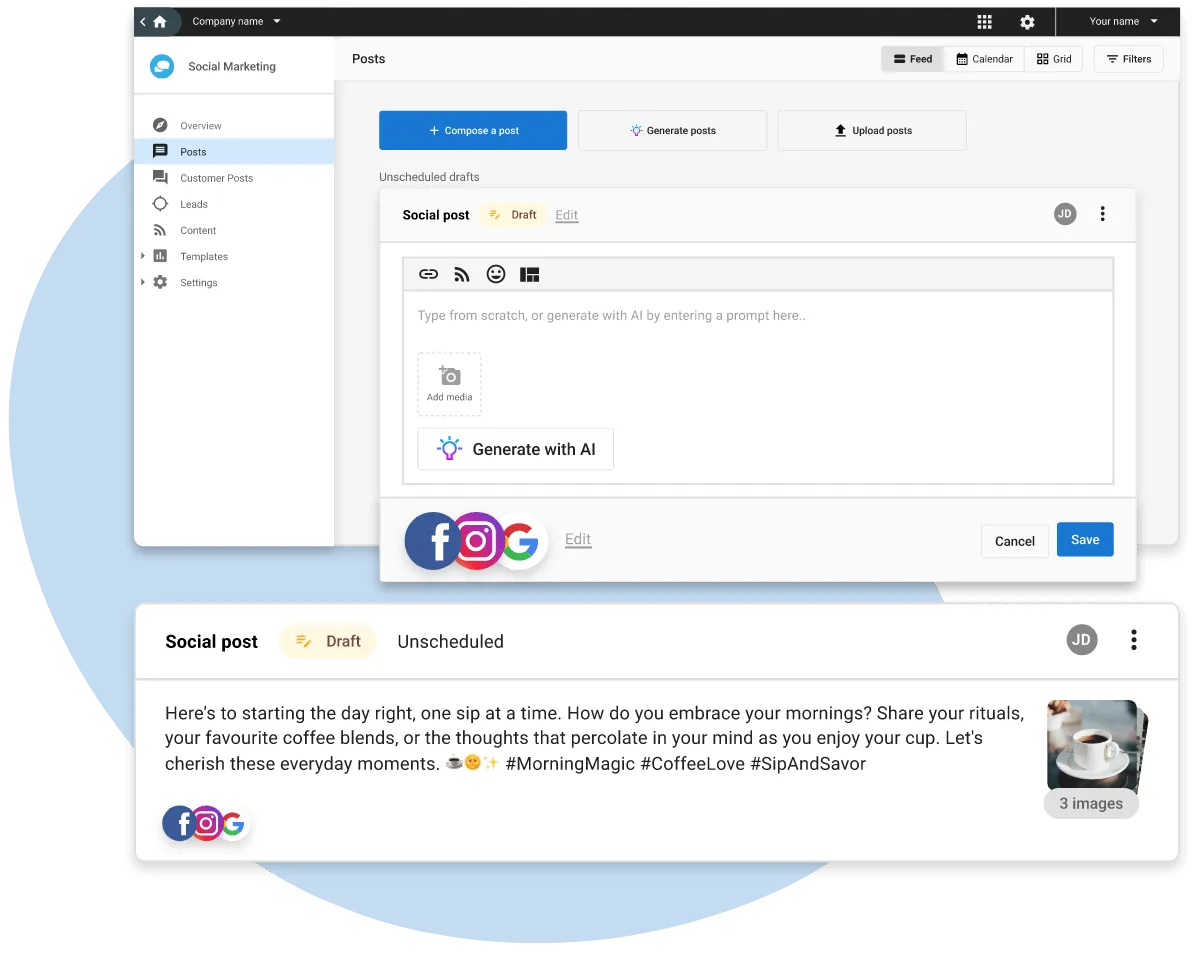
AI-Powered Content Curation
AI doesn’t just create content—it also helps you find and share the best. Tools like Feedly AI and Curata analyze trending topics and audience preferences, suggesting relevant articles for your social media or newsletters. No more guesswork—just great content.
SEO-Optimized Content
AI tools like SurferSEO, Clearscope, and Frase help marketers dominate search rankings by:
- Identifying top-ranking keywords with high search intent
- Optimizing content in real-time for better Google visibility
- Suggesting internal links and topic clusters to boost SEO authority
AI doesn’t just help you create content—it ensures that content ranks, engages, and converts.
AI for Advertising & PPC Campaigns
AI has revolutionized digital advertising by automating tedious tasks, optimizing bids, and ensuring your ads reach the right people.
- Automated Ad Bidding: Google Ads’ Smart Bidding and Facebook’s AI-driven ad delivery take the guesswork out of budget allocation. AI adjusts your bids in real time, ensuring you maximize ROI while reducing wasted spend.
- AI-Generated Ad Creatives: Struggling with ad design? AI-powered tools like Canva AI and AdCreative.ai create high-converting ad banners, video thumbnails, and image variations in seconds—ensuring every ad looks professional and performs at its best.
- Audience Targeting & Segmentation: AI can analyze customer data to identify ultra-specific audience segments based on behavior, interests, and demographics. Platforms like Meta Ads, Google Ads, and Criteo use AI to deliver laser-targeted ads that reach the right customers at the right moment.
AI for Email & Outreach Automation
Email marketing is still one of the highest ROI channels, and AI makes it even more powerful with automation, personalization, and predictive analytics.
- Personalized AI Email Sequences: AI-powered tools like Yesware, Vendasta’s Campaigns Pro, and HubSpot can automate cold outreach and follow-ups, ensuring your emails feel human and timely—but without the manual effort.
- Predictive Email Send Times: AI analyzes past email performance to find the best time to send messages based on when recipients are most likely to open and engage.
- AI-Powered Subject Line Testing: Tools like Phrasee and Persado use AI to analyze past campaign performance and suggest the most effective subject lines for higher open rates.
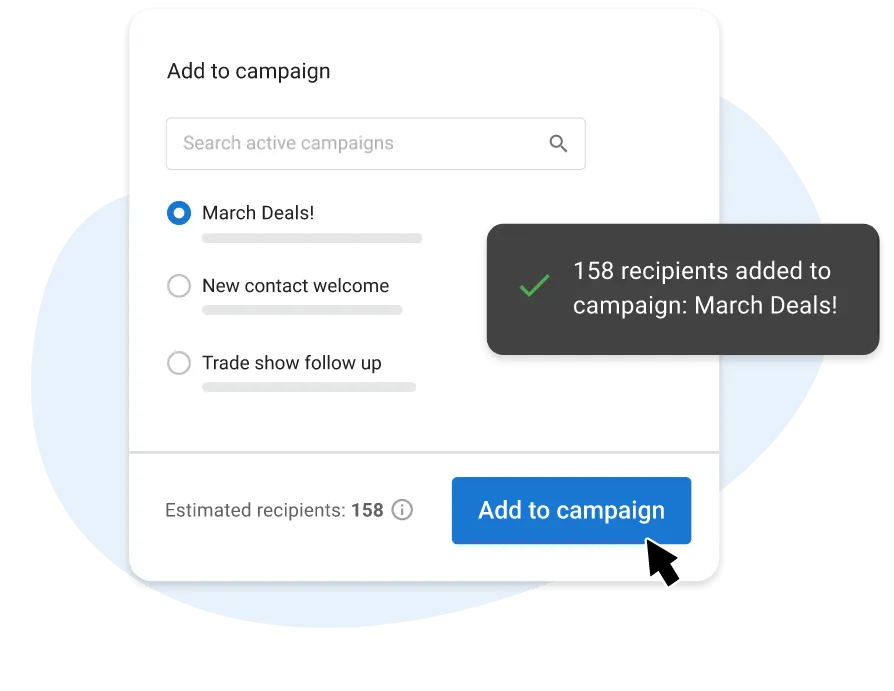
More engagement. More conversions. Less manual work.
AI-Powered Chatbots & Customer Engagement
AI chatbots have completely transformed customer service, making instant, 24/7 support a reality.
24/7 AI Chatbots
AI chatbots handle customer inquiries, lead qualification, and even sales support—without human intervention. This means:
- Faster response times
- Higher engagement
- More conversions
Check out this video that highlights how Vendasta’s AI-assisted webchat helps agencies capture leads quickly.
AI Voice Assistants
AI-driven IVR (Interactive Voice Response) systems help businesses manage high call volumes, answer FAQs, and direct customers without a live agent. AI-powered voice assistants (like Alexa and Google Assistant) are also opening new ways for voice search marketing.
Sentiment Analysis
AI tools like MonkeyLearn and Brandwatch scan reviews, social media, and customer feedback to detect sentiment (positive, negative, neutral), helping brands understand customer emotions and respond effectively.
AI for SEO & Search Marketing
AI is revolutionizing SEO strategies with intelligent automation, smarter keyword research, and real-time optimization.
- AI-Powered Keyword Research: AI-driven tools like SEMrush, Ahrefs, and MarketMuse suggest high-intent, low-competition keywords, helping you target the right search queries for better rankings.
- Automated SEO Auditing & Fixes: SurferSEO and Screaming Frog scan websites for technical SEO issues (broken links, slow load speeds, missing meta tags) and provide instant fixes, improving site health and rankings.
- AI for Content Clustering & Topic Authority: AI helps brands develop agency content strategies, ensuring your website builds topical authority and ranks higher for competitive keywords.
AI for Social Media Marketing
Social media is fast-moving, and AI helps brands stay ahead by automating engagement, tracking trends, and optimizing content.
- AI-Generated Post Suggestions: AI tools like Lately.ai and Buffer AI analyze trending topics, past engagement, and competitor content to suggest the best-performing post ideas.
- AI-Powered Social Listening: Sprout Social, Brandwatch, and Hootsuite Insights track brand mentions, audience sentiment, and competitor activity—helping brands stay informed and react instantly.
- Automated Engagement: AI chatbots can auto-reply to social media DMs and comments, ensuring fast responses and higher engagement on platforms like Instagram, Facebook, and Twitter.
Pro Tip: Vendasta’s Social Marketing is a white-label social media management software for agencies that helps you manage thousands of client accounts under one roof. With AI-powered tools and streamlined workflows, you can unlock great revenue opportunities.
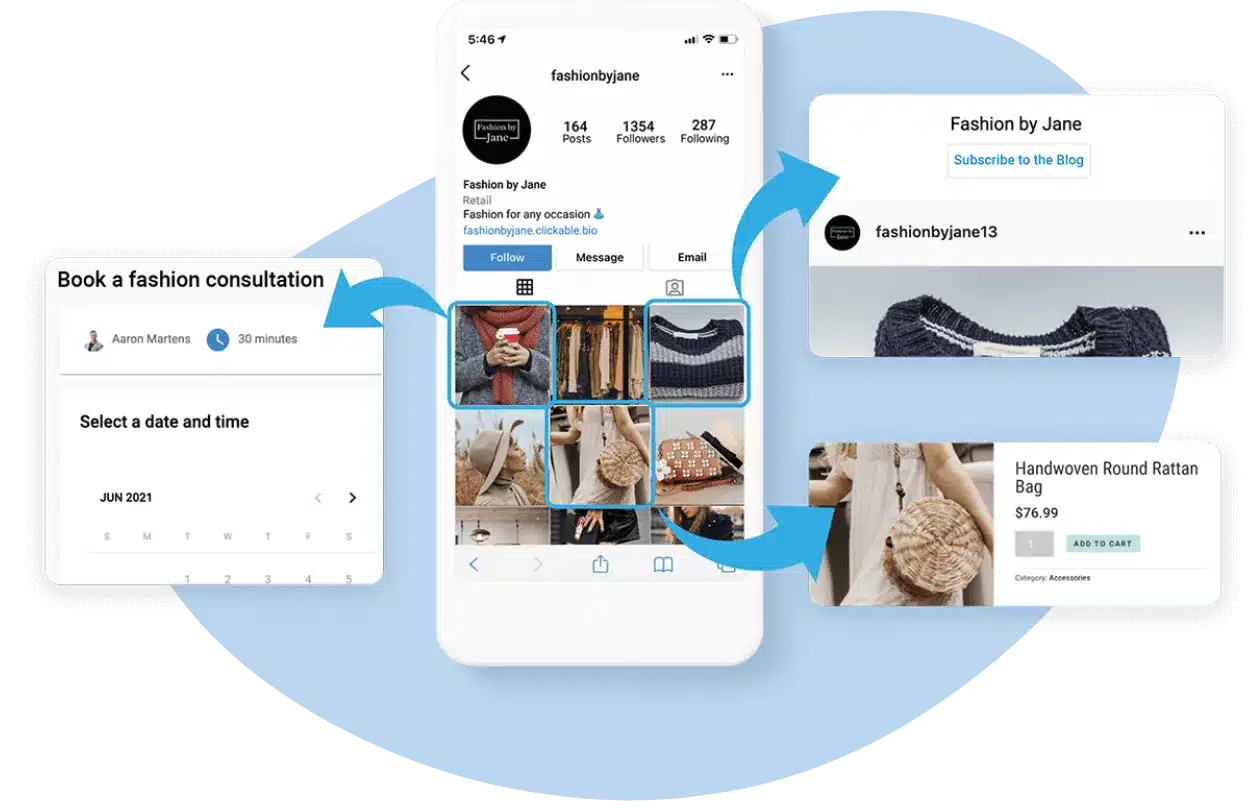
How to Implement AI in Your Agency’s Marketing Strategy
Next on our AI cheat sheet is implementation. It’s crucial to understand where AI can provide the most value in your marketing strategy. This means analyzing your current workflows, identifying bottlenecks, and defining clear objectives for AI implementation.
Step 1: Assess Your Needs – Where Can AI Help?
Conduct a Marketing Process Audit
A thorough marketing audit helps you pinpoint where your team is spending unnecessary time on manual tasks and where AI can streamline operations.
Review All Marketing Processes
Look at your daily, weekly, and monthly marketing activities. Identify tasks that involve:
- Manual effort: Are there processes that require human input but could be automated?
- Repetitive actions: Are you constantly scheduling the same types of emails, analyzing reports, or responding to similar customer queries?
- Large-scale data analysis: Do you struggle with analyzing ad performance, customer behavior, or SEO trends? AI excels at processing large amounts of data quickly and accurately.
Assess Bottlenecks
Ask yourself and your team:
- Where are we spending excessive time on non-strategic tasks?
- Which processes slow down our workflow?
- What tasks are error-prone due to manual execution?
Here are common bottlenecks AI can solve:
- Manually analyzing campaign performance: AI can automate reporting and suggest optimizations in real time.
- Responding to basic customer inquiries: AI chatbots can handle FAQs, freeing up human agents for complex issues.
- Creating repetitive content (ads, emails, social posts, reports): AI content generators can speed up and enhance production.
- SEO and keyword research taking too long: AI-powered SEO tools provide automated insights and recommendations.
Identify Gaps in Service Delivery
Even if your team is performing well, AI can help uncover opportunities for improvement. Look for areas where AI can:
- Enhance customer experience
- Improve efficiency
- Increase marketing ROI
Here are examples of AI Gaps in service delivery:
- Lead Scoring & Email Personalization: If your email marketing lacks advanced segmentation, AI can score leads and send hyper-personalized emails based on user behavior.
- SEO Strategy is Reactive, Not Proactive: If you’re only making SEO updates after rankings drop, AI can help predict search trends and optimize content proactively.
- Ad Targeting & Optimization is Manual: AI-powered ad platforms like Google Smart Bidding and Meta Advantage+ can automate and optimize PPC bidding strategies for better ROI.
Key Takeaway: AI works best when applied to repetitive, data-heavy, or predictive tasks that can free up your team for strategy and creativity.
Define Your AI Objectives
Once you’ve identified areas where AI can help, it’s time to set clear objectives. Your AI strategy should align with your overall marketing goals—whether it’s saving time, boosting engagement, improving conversions, or optimizing ad spend.
What specific goals do you want AI to achieve?
- Increase efficiency by automating time-consuming tasks
Example: Use AI-driven automation to schedule social media posts, email sequences, and reporting. - Improve campaign performance through AI-powered optimization
Example: Leverage AI in Google Ads Smart Bidding to optimize conversion rates without manual adjustments. - Enhance client reporting and analytics with AI-driven insights
Example: Use AI analytics tools like Google Analytics 4 (GA4) and Tableau AI to provide real-time insights on campaign performance. - Deliver more personalized marketing campaigns with AI-driven segmentation
Example: Use AI-powered CRMs like Vendasta’s AI-CRM, Salesforce Einstein, or ActiveCampaign to create hyper-personalized email sequences based on user behavior.
Prioritize AI Use Cases Based on Urgency, Impact & Feasibility
Not all AI applications need to be implemented at once. Prioritize them based on three factors:
- Urgency: What problem is most pressing for your business? (e.g., slow response times, inefficient ad spending, low email engagement)
- Impact: Which AI application will drive the highest ROI and business value?
- Feasibility: How easy is it to implement with your current tools and budget?
Now that you’ve assessed your needs, identified gaps, and set clear AI objectives, it’s time to select the right AI tools to execute your strategy.
Step 2: Select the Right AI Tools for Your Agency
Here’s a breakdown of the best AI-powered tools for AI-content marketing, PPC, email automation, analytics, and customer engagement—so you can automate, optimize, and scale your marketing efforts efficiently.
AI for Content & SEO Optimization
Content and SEO go hand in hand, and AI can help you create, optimize, and rank content faster than ever before.
1. Vendasta AI Content Creator
Vendasta AI Content Creator automates blog writing, social media posts, and email copy using AI-generated content tailored to your audience.
Why use it? Great for agencies that need to produce high-volume content without sacrificing quality.
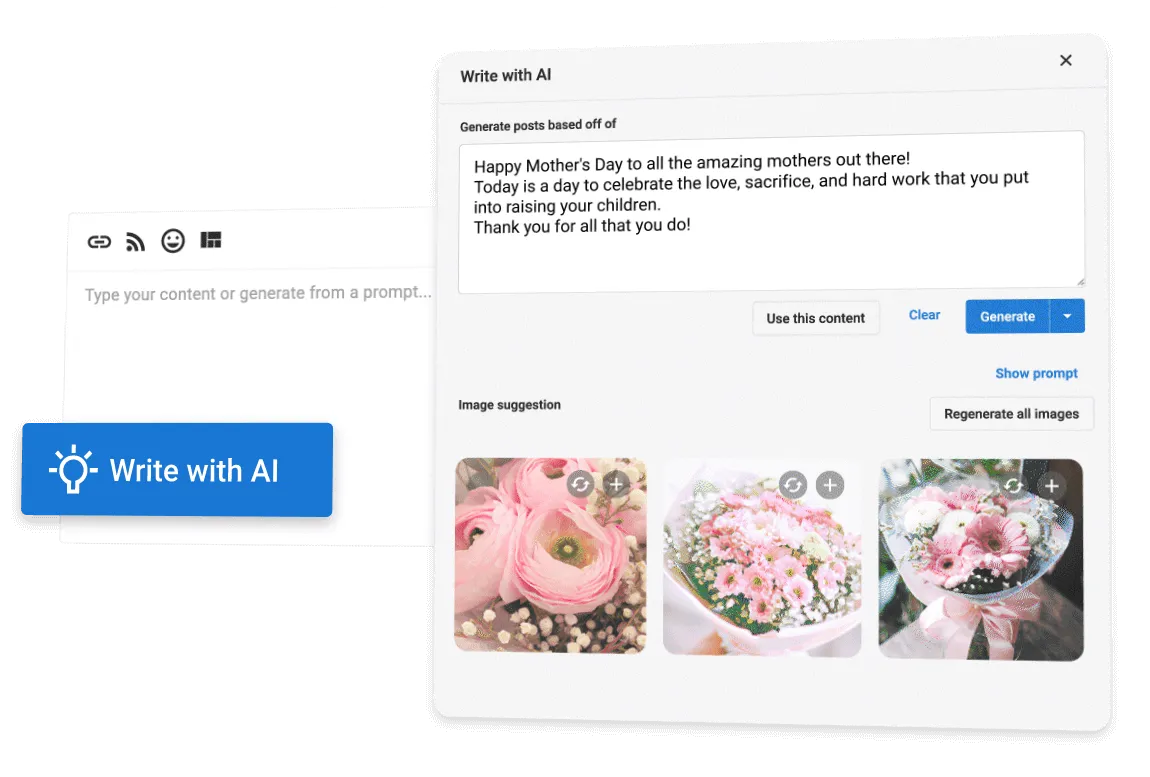
Key Features:
- AI-powered content suggestions & automation
- Pre-written templates for blogs, social posts, and emails
- Easy integration with agency marketing platforms
2. Surfer SEO
Surfer SEO uses AI to analyze top-ranking content and provide SEO-optimized recommendations for higher search rankings.
Why use it? Helps agencies create SEO-rich content without manually analyzing competitors.
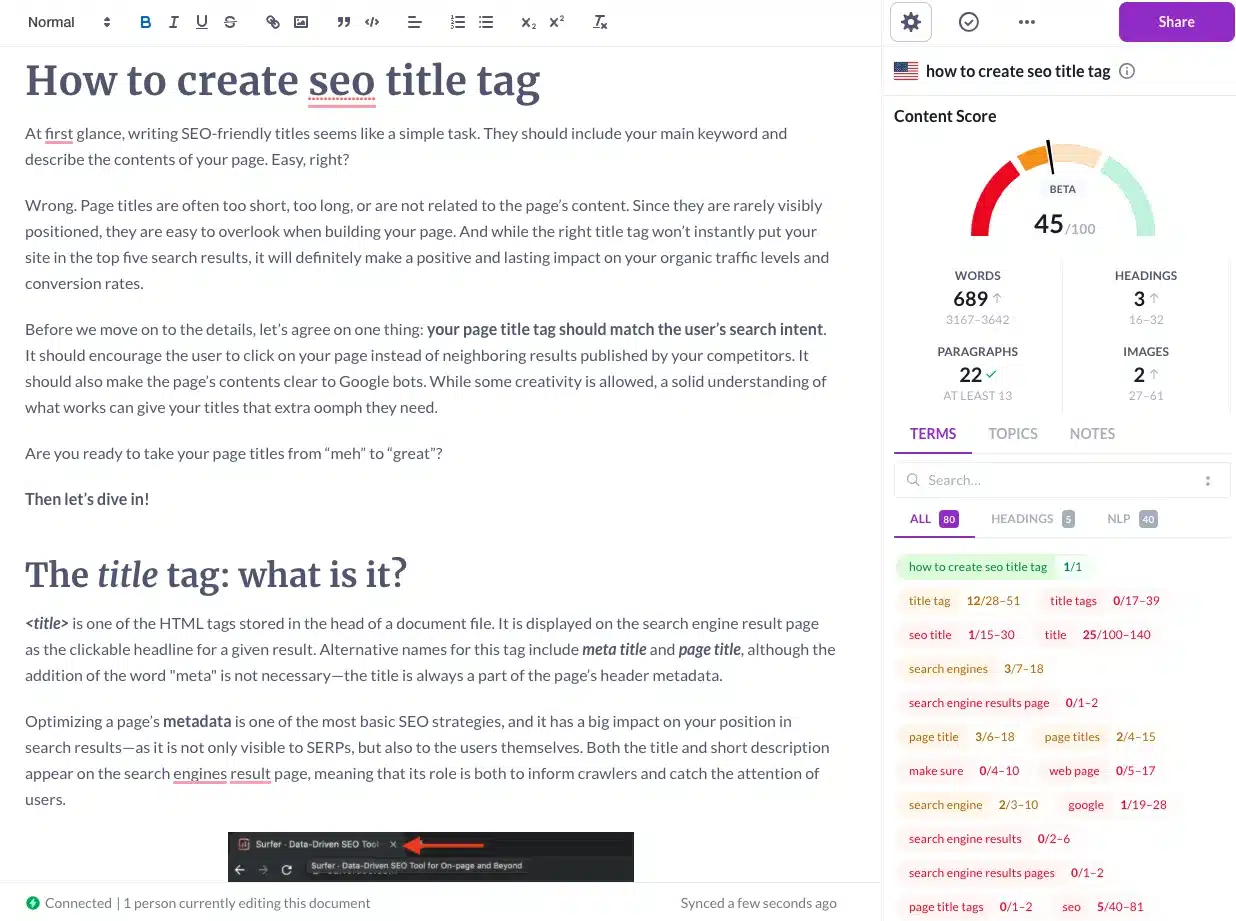
Key Features:
- AI-driven keyword research & content structuring
- Real-time SEO grading & optimization suggestions
- Integrates with Google Docs & WordPress
3. Clearscope
Clearscope uses AI to grade content quality and provide SEO recommendations based on search intent.
Why use it? Ensures content ranks well and matches what users are searching for.
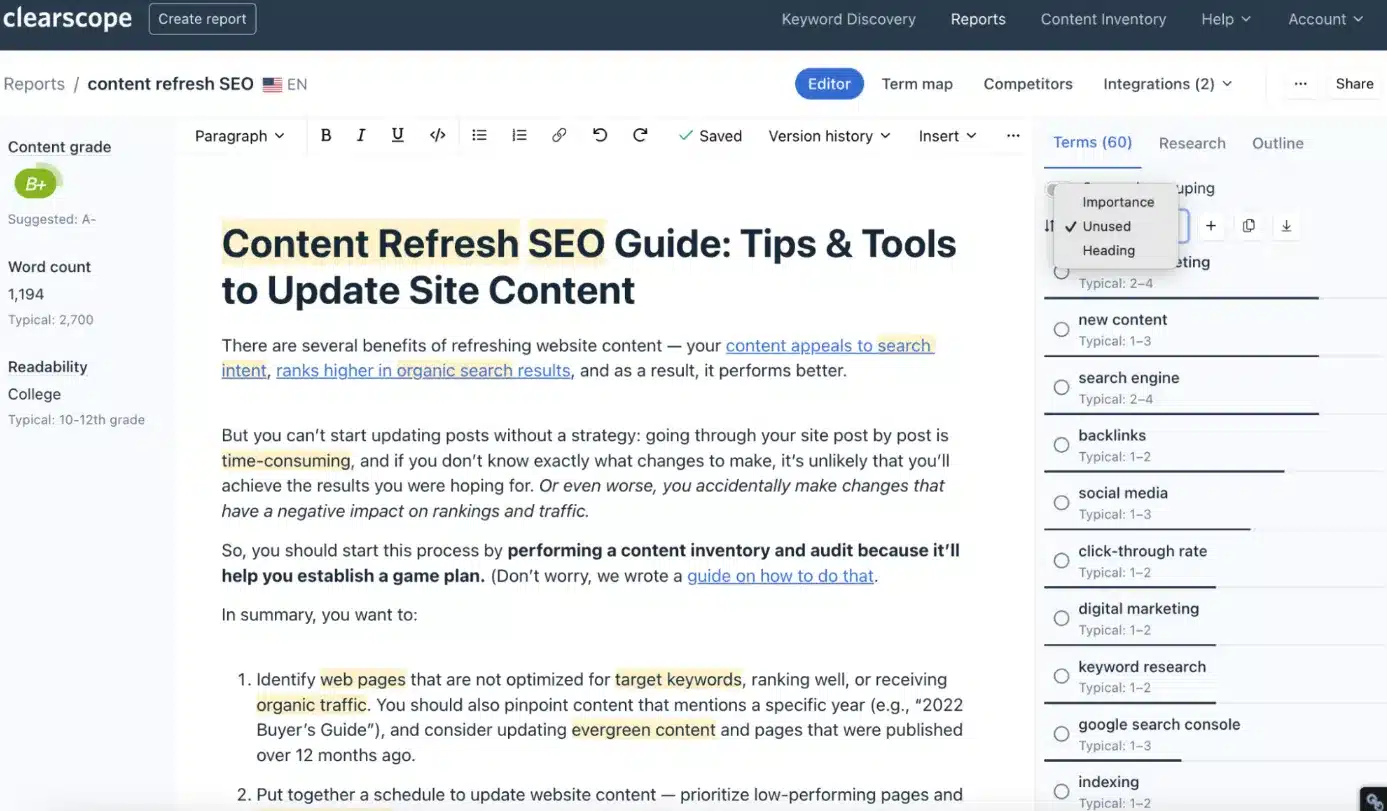
Key Features:
- AI-powered content scoring & topic suggestions
- Keyword & semantic SEO recommendations
- Helps writers create high-quality, rankable content
AI for Ad & PPC Management
AI takes the guesswork out of ad optimization by automating bid adjustments, improving targeting, and generating high-performing ad creatives.
1. Google AI Smart Bidding
Google AI Smart Bidding uses AI to automate PPC bidding strategies for maximum ROI.
Why use it? Ensures you spend less time adjusting bids and more time optimizing strategy.
Key Features:
- Real-time bid optimization for conversions
- Predictive analysis to adjust bids based on user behavior
- Works across Google Ads & YouTube Ads
2. Adzooma
Adzooma is an AI-powered ad management platform that automates bid adjustments, performance tracking, and ad improvements.
Why use it? Helps agencies scale ad campaigns efficiently with AI-driven insights.
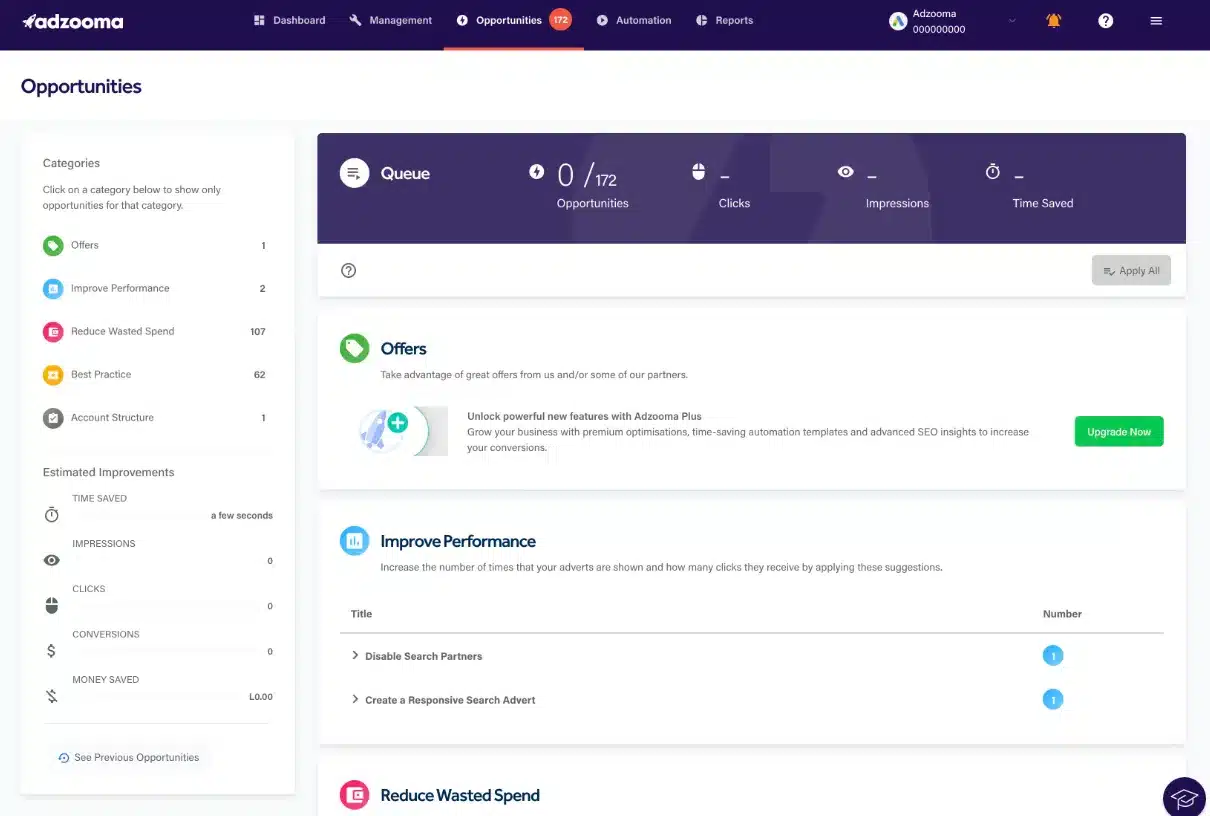
Key Features:
- AI-driven bid optimization & automation
- Campaign performance alerts & recommendations
- Cross-platform support (Google, Facebook, Microsoft Ads)
3. Persado AI
Persado AI leverages AI to generate, test, and optimize ad creatives for better engagement.
Why use it? Helps ad agencies create more effective ad copy with real-time AI insights.
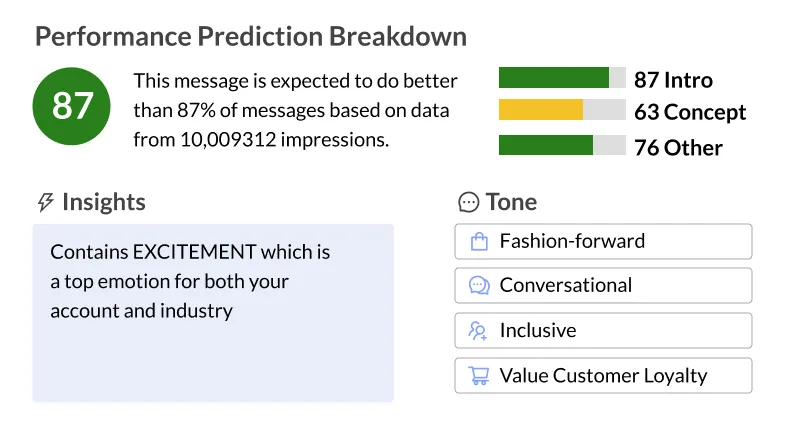
Key Features:
- AI-generated ad headlines & descriptions
- Real-time creative performance tracking
- Predictive engagement scoring
Best For: Agencies that manage multiple ad campaigns and need AI assistance for performance tracking and creative generation.
AI for Email & Sales Automation
AI-powered email tools can automate outreach, optimize email timing, and personalize campaigns for higher engagement rates.
1. Vendasta Yesware
Vendasta’s product Yesware leverages AI-powered email outreach automation with personalized follow-ups & engagement tracking.
Why use it? Great for automating cold outreach & sales sequences.
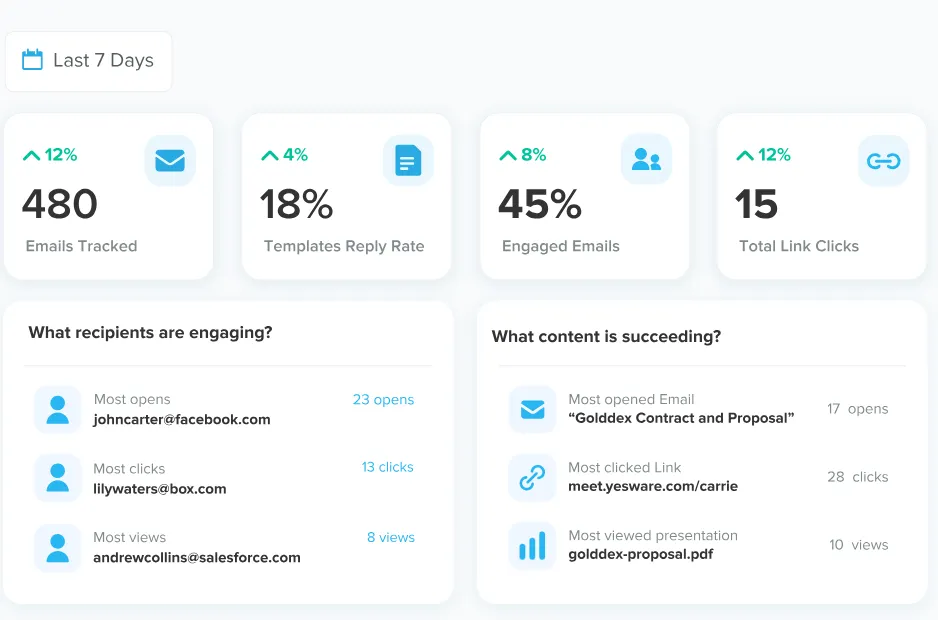
Key Features:
- AI-powered email personalization
- Automated follow-up sequences
- Real-time email engagement tracking
2. Mailchimp AI
Mailchimp AI uses AI to predict email engagement and automate email sequences based on audience behavior.
Why use it? Helps marketers send emails at the perfect time for engagement.
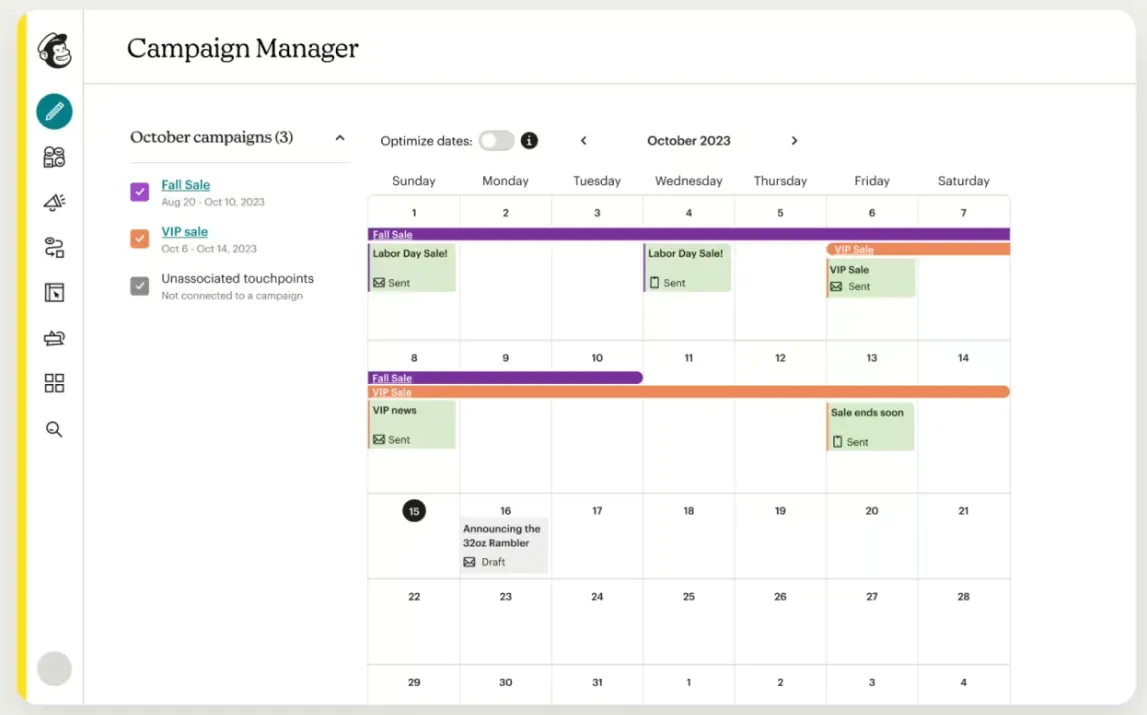
Key Features:
- AI-driven send-time optimization
- Smart audience segmentation
- Predictive email engagement scoring
3. Vendasta AI Email Automation
Vendasta AI Email Automation helps agencies automate client outreach and nurture SMB clients with AI-driven, timely messaging.
Why use it? Keeps clients engaged with personalized, data-driven messaging.
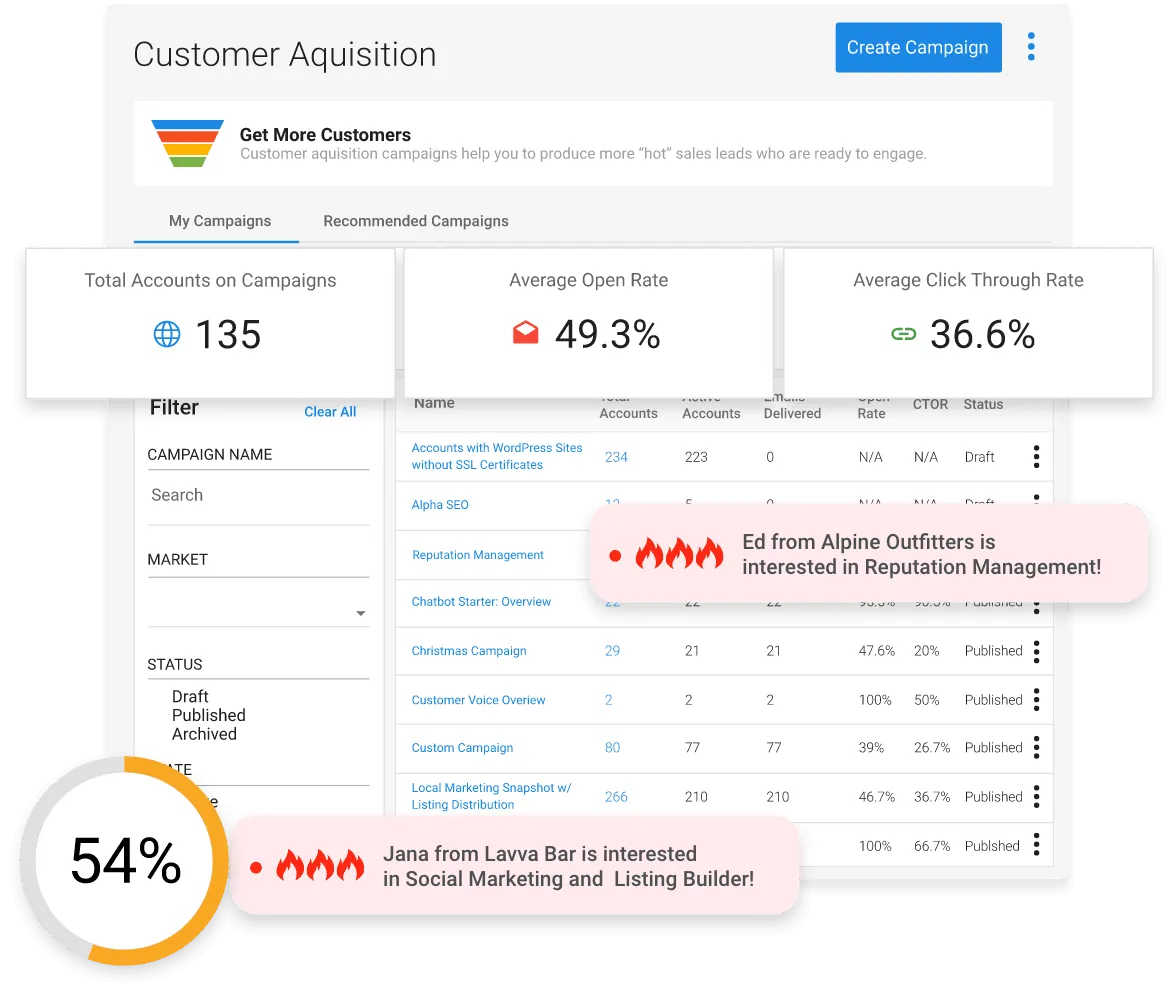
Key Features:
- AI-powered email personalization & automation
- Automated client follow-ups
- Performance tracking & analytics
AI for Client Reporting & Analytics
AI-powered reporting tools help agencies automate client reports, track cross-platform performance, and deliver actionable insights.
1. Vendasta’s Executive Report
Vendasta’s Executive Report is an AI-powered client performance report that comes with automated insights.
Why use it? Saves agencies hours of manual report creation.
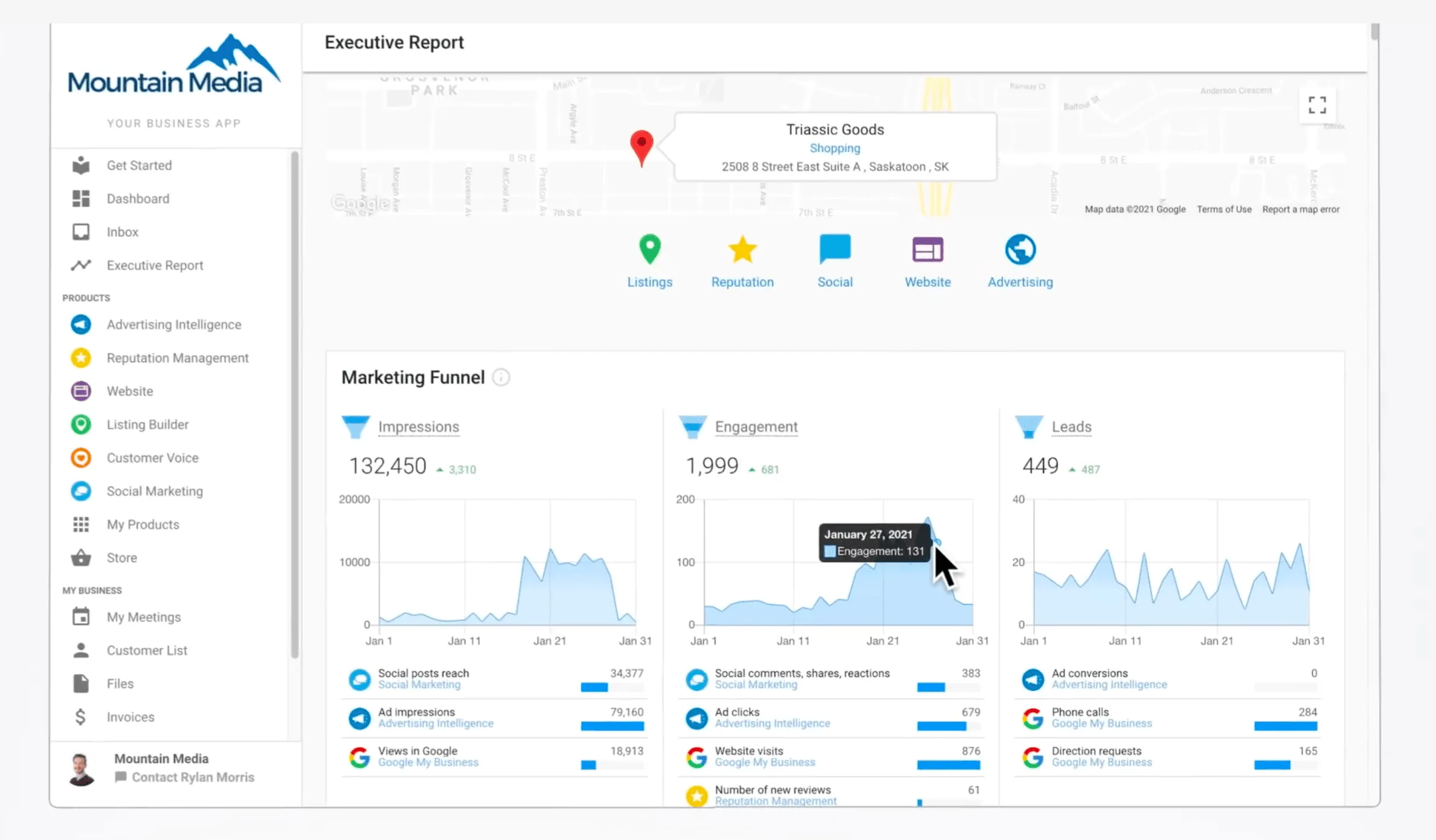
Key Features:
- AI-generated marketing performance reports
- Automated client insights & recommendations
- Multi-platform data integration
2. DashThis
DashThis provides AI-powered marketing dashboards that pull insights from multiple marketing platforms.
Why use it? Consolidates all marketing data into one easy-to-read dashboard.
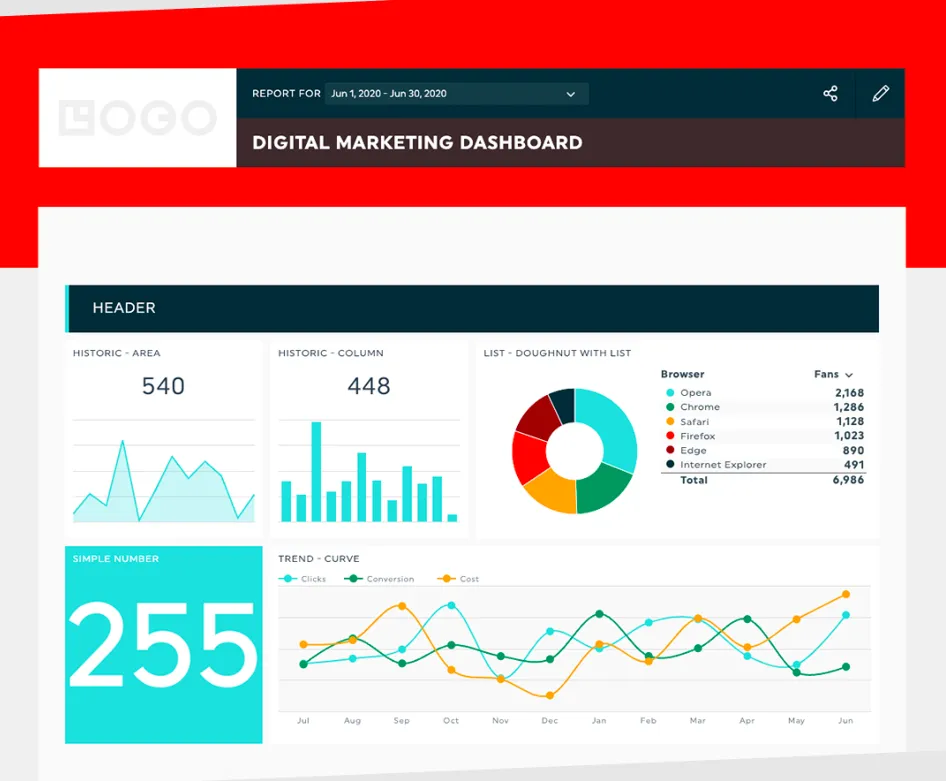
Key Features:
- Automated cross-platform reporting
- AI-driven performance tracking
- Custom client reports
3. Google Analytics 4 (GA4) AI Insights
Google Analytics 4 uses machine learning to detect trends, anomalies, and predict user behavior.
Why use it? Helps marketers spot opportunities and risks before they happen.
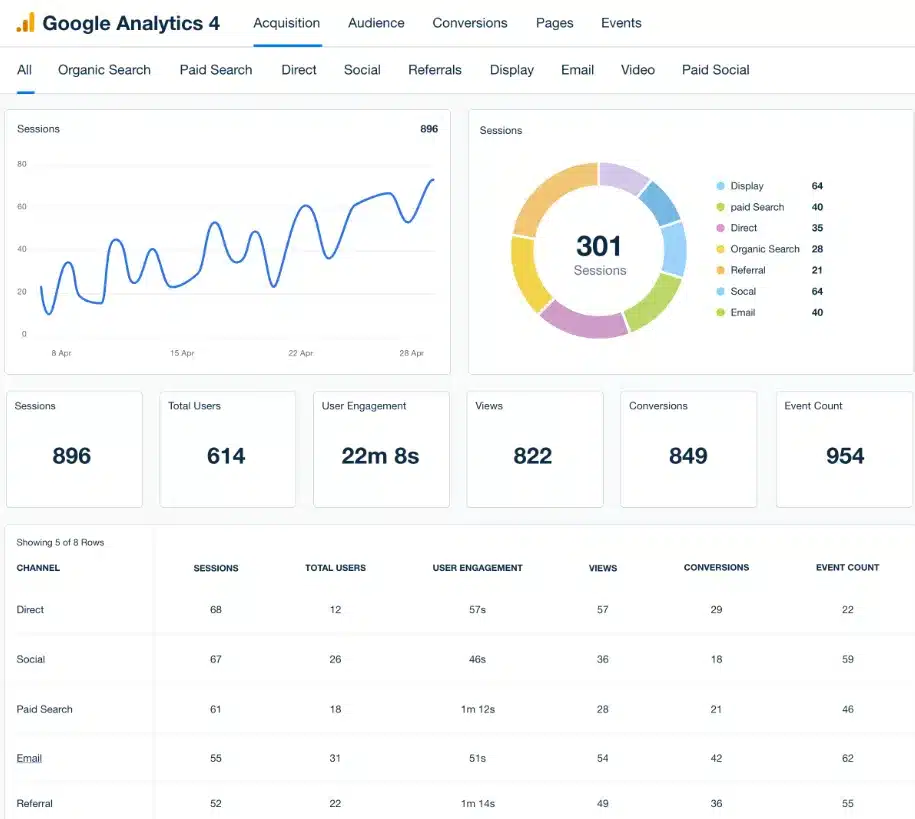
Key Features:
- AI-driven trend analysis
- Predictive conversion tracking
- Automated marketing insights
Best For: Agencies that need in-depth analytics & AI-driven client reporting.
AI for Customer Engagement & Support
AI-powered chatbots and automation tools streamline customer interactions, improve response times, and enhance user experience.
1. Vendasta’s AI Chatbots
Vendasta’s AI Web Chatbots help with SMB client interactions, lead generation, and support.

Key Features:
- AI lead qualification & engagement
- 24/7 customer support automation
- AI-generated chat responses
2. Drift AI Chatbots
Drift AI Chatbots create personalized chatbot conversations to boost sales and customer engagement.
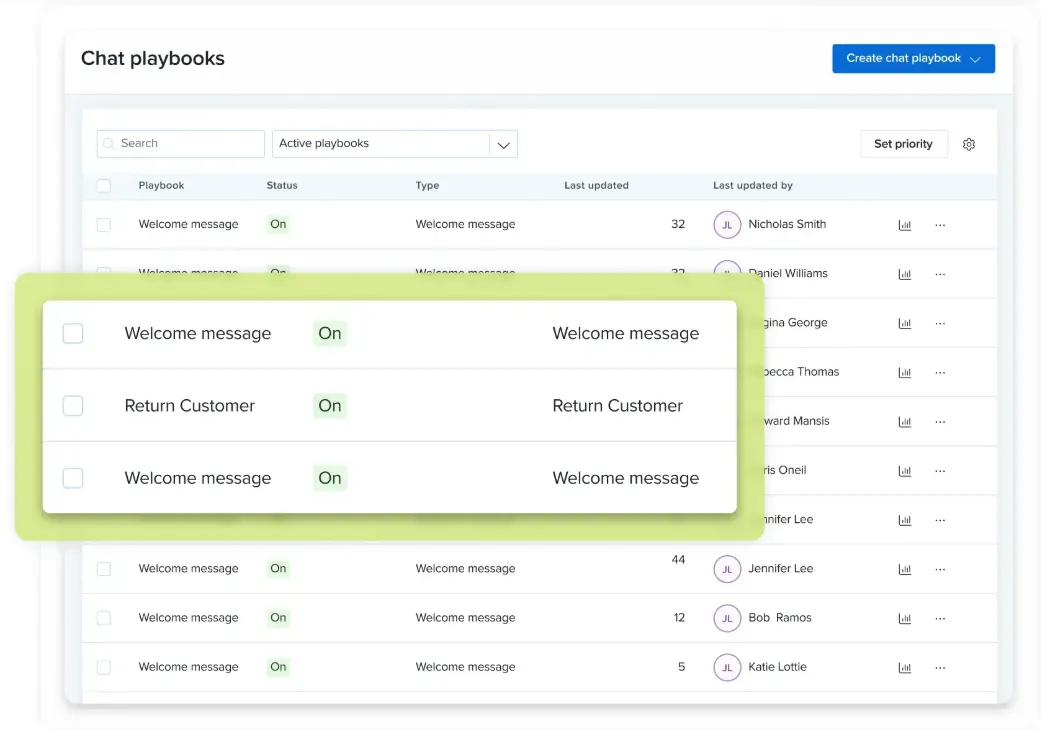
Key Features:
- AI-powered lead nurturing
- Personalized chat sequences
- CRM integration
Step 3: Create an AI Implementation Plan
Here’s how to successfully integrate AI into your marketing strategy in three phases:
Phase 1: Pilot AI in One Department or Service
Instead of applying AI across all operations at once, test it in one department or service where it can deliver quick wins.
Choose an area that:
- Requires minimal setup & training
- Has a measurable impact on efficiency & performance
- Provides valuable insights before full-scale adoption
Here are example use cases for AI piloting:
- Content Marketing: Use AI-generated content for social media posts, blog writing, or email newsletters.
- PPC Optimization: Test Google AI Smart Bidding to automate PPC bid strategies.
- Customer Support: Implement an AI chatbot to handle FAQs and lead qualification.
Before expanding AI adoption, evaluate its impact by analyzing:
- Performance Metrics: Did AI improve efficiency, reduce workload, or enhance results?
- Team Adoption: How easy was it for the team to use and integrate into workflows?
- ROI Potential: Did AI help cut costs or increase conversions?
Decision Point: If AI proves beneficial, move to Phase 2. If not, refine your approach and test different AI use cases.
Phase 2: Expand AI Usage Gradually
Once AI has proven its value in one area, it’s time to expand into other services while keeping adoption manageable and strategic.
Gradual AI expansion strategy:
- Scale Within the Same Function.
- Example: If AI-generated content works well for social media, expand it to blog writing, email copy, and ad creatives.
- Expand to Adjacent Services.
- Example: If AI-optimized content improves blog SEO, integrate AI-powered keyword research and automated SEO auditing.
- Enhance Client Services with AI Insights.
- Example: If AI reporting improves internal decision-making, use it for client analytics and automated reporting dashboards.
Monitor progress and optimize AI workflows:
As AI adoption expands, continue measuring performance with key metrics.
- Time savings: Are teams spending less time on repetitive tasks?
- Performance improvements: Are campaigns generating better results?
- Client impact: Are AI-driven insights improving client satisfaction?
Decision Point: Once AI is effectively supporting multiple services, proceed to full AI integration.
Phase 3: Full AI Integration Across Services
By this stage, AI should be fully embedded in your agency’s operations, powering everything from content creation to client reporting.
To maximize AI’s impact, set up automated workflows where AI tools work together seamlessly.
Here’s an example of a fully integrated AI workflow:
- Step 1: AI analyzes audience behavior → (Google Analytics AI)
- Step 2: AI generates SEO-optimized content → (Surfer SEO + Jasper)
- Step 3: AI automates email & social media posts → (Vendasta Social Marketing + Campaigns Pro)
- Step 4: AI optimizes ad targeting & bidding → (Google AI Smart Bidding + Persado)
- Step 5: AI-powered chatbots engage leads → (Vendasta AI Chatbots)
- Step 6: AI generates client performance reports → (Vendasta Executive Report)
Step 4: Train Your Team to Use AI Effectively
AI is a powerful tool, but its success depends on how well your team understands and uses it. The goal is to ensure that AI enhances productivity, improves marketing performance, and integrates smoothly into daily workflows—without replacing human creativity and strategic thinking.
Here’s how to train your team to embrace AI readiness and set them up for success:
1. Create a Learning Program for AI Adoption
Adopting AI isn’t just about introducing new tools—it requires a cultural shift where teams feel confident, capable, and excited about AI’s potential.
2. Provide Hands-On AI Training
Formal training helps your employees effectively integrate AI into their roles. Implement:
- Interactive Workshops – Hands-on training with tools like ChatGPT, Google AI Smart Bidding, Surfer SEO, or Jasper.
- Webinars & Expert Sessions – Industry experts share real-world AI applications.
- AI E-Learning Courses – Access platforms like Coursera, Udemy, or HubSpot Academy.
- Tool Demos & Case Studies – Showcase AI’s impact on business performance.
Example: Run a workshop comparing AI vs. human-generated content, then A/B test engagement, SEO, and conversion rates.
3. Encourage Team Members to Experiment with AI-Driven Processes
Hands-on experience is the best way to learn AI. Empower your team to test AI features and experiment in low-risk scenarios.
- Marketing Teams: Test AI-generated ad copy, blog posts, or social media captions, then analyze engagement metrics.
- SEO Teams: Use AI for keyword research and content optimization, then track search ranking improvements.
- Email Teams: Implement AI-powered subject line testing and analyze open rate performance.
- PPC Teams: Run AI-optimized ad campaigns and compare results with manually managed ones.
4. Assign AI Champions Within the Agency
To drive AI adoption, assign AI Champions—team members who master AI tools, provide internal training, and stay updated on AI trends. Choose individuals who enjoy tech, are problem-solvers willing to experiment, and can effectively train colleagues. Incentivize participation with AI certifications, exclusive training, or leadership opportunities.
5. Establish AI Best Practices
To maximize AI’s impact, your team should follow best practices that ensure AI tools are used ethically, effectively, and strategically.
AI is a tool, not a replacement for human expertise.
AI should enhance, not replace, human creativity. Teams must review AI-generated content for accuracy and brand voice, ensure ethical use by maintaining human oversight in sensitive interactions, and customize outputs for authenticity.
Example: Always edit AI-generated social media posts for tone and accuracy before publishing.
6. Train Teams on AI-Driven Data Interpretation
AI provides valuable insights, but marketers must interpret them wisely. Validate AI-driven PPC and SEO recommendations, analyze AI-generated reports in context, and avoid over-reliance by blending AI insights with human strategy.
Example: AI may identify a high-performing ad segment, but A/B testing is essential before scaling.
Step 5: Monitor Performance & Optimize AI Usage
To ensure that AI is driving success for your agency, you need a structured approach to measuring impact, reviewing performance, and making necessary adjustments.
Here’s how to track AI’s success and optimize its usage over time.
1. Define AI Success Metrics
Measure AI’s effectiveness with clear KPIs aligned to your agency’s goals:
Efficiency Gains:
- Compare the time spent on AI-automated vs. manual tasks.
- Track workload shifts—has AI freed up time for strategic work?
- Example: AI-powered bidding reduced PPC analysis time from 10 hours to 2 hours per week (80% savings).
Performance Improvements:
- Are AI-driven ads lowering CPC and boosting CTR?
- Is AI email automation increasing open rates and conversions?
- Example: AI-optimized subject lines increased email open rates by 50%.
Client Satisfaction & Retention:
- Has AI improved client retention and campaign results?
- Are AI reports and automation delivering value?
- Example: AI-generated reports reduced churn by 20% by providing actionable insights.
2. Regularly Review & Optimize AI Strategy
To ensure AI continues delivering value, conduct quarterly AI audits to analyze effectiveness and identify areas for improvement.
- Analyze AI tool effectiveness: Are AI tools still meeting expectations?
- Compare AI vs. human performance: Is AI improving efficiency or creating extra work?
- Review cost vs. benefit: Is AI saving time and improving ROI relative to its cost?
Here’s an example:
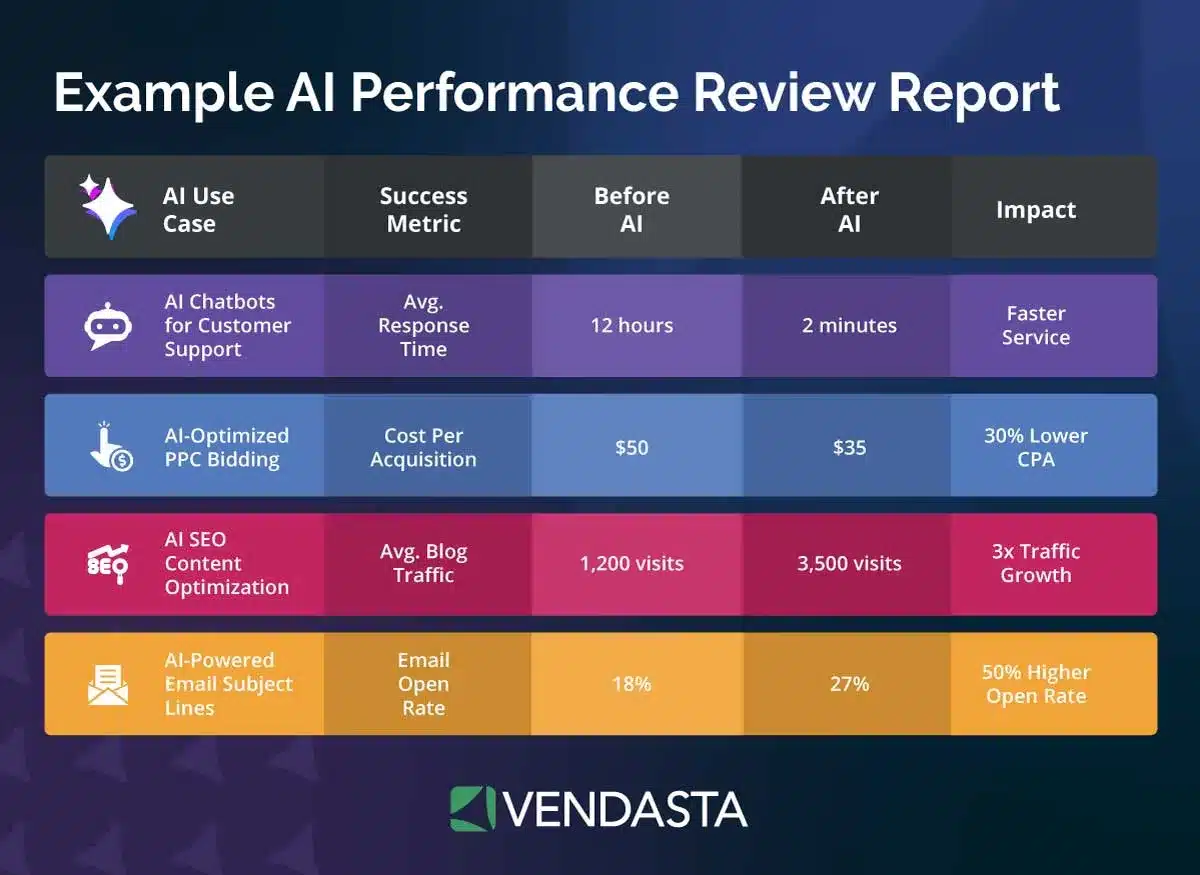
Identify and adjust underperforming AI areas:
- Analyze why AI is underperforming: Is the tool learning slowly, or is it being misused?
- Refine AI settings: Adjust recommendations, targeting, or training data.
- Test alternative tools: If an AI tool isn’t delivering, explore better options.
- Example: AI ad creatives underperformed → Adjusted messaging → CTR increased by 25%.
3. Stay Updated on AI Advancements & Emerging Trends
AI evolves rapidly—staying informed helps maintain a competitive edge. How to stay updated:
How to stay updated:
- Follow AI marketing blogs & industry reports.
- Attend AI-focused webinars & conferences to learn about new tools & strategies.
- Test new AI features & updates regularly to keep your agency’s AI capabilities at peak performance.
Step 6: Scale AI for Competitive Advantage
Once AI is successfully integrated into your agency’s operations, it’s time to scale AI usage to drive competitive advantage. AI can do more than optimize internal workflows—it can be leveraged to offer AI-powered services, refine marketing strategies, and position your agency as an AI thought leader.
Here’s how to scale AI adoption and use it as a differentiator in the digital marketing industry.
Develop AI-Powered Service Offerings for SMB Clients
AI isn’t just for internal optimization—it can be packaged as a premium service for clients. By offering AI-driven marketing solutions, your agency can attract SMBs looking for smarter, automated, and data-driven campaigns.
- AI Driven PPC Management: AI tools automate ad spend optimization. Offer AI-powered bidding & budget allocation to lower CPA and boost conversions, AI-generated ad creatives to enhance messaging, and predictive audience targeting to reach high-intent users.
- AI-Powered Automated Reputation Management: Small businesses can streamline online review management with AI. Solutions like Vendasta AI automatically respond to reviews, analyze sentiment trends, and monitor brand mentions to inform PR strategies. Check out this video below to learn how you can use AI to generate thoughtful review responses.
- AI-Powered Content & SEO Services: Leverage AI for SEO-optimized content creation, keyword research, and trend forecasting. Tools like Jasper AI and Surfer SEO generate and optimize content, SEMrush AI automates keyword clustering, and predictive analytics help stay ahead of search trends.
Use AI Insights to Refine Marketing Strategies
AI isn’t just about automation—it provides deep insights that can shape smarter marketing decisions. By leveraging AI-driven analytics, your agency can:
- Adjust Campaigns Based on Predictive Analytics: AI tools like Google Analytics 4, DashThis, and Vendasta AI predict customer behavior using machine learning. Use AI to detect at-risk customers and suggest re-engagement strategies, forecast seasonal trends based on historical data, and optimize email & social campaigns by predicting the best send times.
- Example: AI predicts retargeting ads will convert 30% better than cold traffic campaigns—adjust budget allocation accordingly.
- Personalize Client Marketing Strategies Using AI Insights: AI-driven segmentation enables hyper-personalized marketing that adapts in real time. Implement dynamic ad targeting that adjusts content based on interactions, AI-powered email sequences that modify frequency based on user activity, and custom AI dashboards for real-time campaign performance tracking.
- Example: AI recommends different ad creatives for returning vs. new customers, increasing engagement rates.
Showcase AI Expertise & Position Your Agency as an Industry Leader
To stand out from competitors, your agency should actively promote AI expertise and demonstrate thought leadership.
- Create AI-Focused Case Studies & Success Stories: Clients need proof that AI delivers results. Develop case studies showcasing AI-driven performance improvements, real client success stories, and before vs. after comparisons demonstrating measurable impact.
- Marketing Idea: Publish a monthly AI performance report highlighting SEO gains, ad performance boosts, and automation time savings.
- Host AI-Focused Webinars & Thought Leadership Events: Position your agency as an AI expert by educating clients on AI’s marketing impact. Offer webinars on AI-driven digital marketing, roundtable discussions with AI vendors, and live AI demos showing improvements in ad targeting, content creation, and SEO.
- Example Webinar: “The Future of AI in Marketing: How SMBs Can Automate, Optimize & Scale.”
- Promote AI Marketing Expertise in Thought Leadership Content: Establish credibility by publishing AI marketing guides, whitepapers, and social content. Share AI trends and insights through LinkedIn, Twitter, and blog posts, or launch a podcast/YouTube series featuring AI experts and case studies.
- Example Blog Titles: “AI in Digital Marketing: 5 Ways AI is Revolutionizing Advertising in 2025” and “Why AI-Powered SEO is Outranking Traditional Strategies.”
Overcoming AI Challenges & Ethical Considerations
A crucial component of our AI cheat sheet is understanding the challenges that come with AI adoption.
AI technologies rely on vast amounts of data to function effectively, but this reliance raises concerns about data privacy, security, and ethical considerations. Governments and regulatory bodies worldwide have implemented stringent laws to ensure data protection, transparency, and accountability.
Understanding these regulations is crucial for businesses and AI practitioners to maintain compliance and build trust with users. Let’s dive into some of the key data privacy regulations around the world:
Key Data Privacy Regulations to Be Aware Of
1. General Data Protection Regulation (GDPR – Europe)
The GDPR, enacted by the European Union, is one of the most comprehensive data privacy regulations globally. It aims to protect the personal data of EU citizens and applies to any organization that collects or processes data from EU residents, regardless of its geographical location.
Key Provisions of GDPR:
- Explicit Consent: Organizations must obtain clear and explicit user consent before collecting personal data.
- Data Subject Rights: Individuals have the right to access, correct, and delete their personal data upon request (Right to Be Forgotten).
- Data Protection by Design: Businesses must incorporate privacy measures into their systems and processes from the outset.
- Breach Notification: Organizations must report data breaches to authorities within 72 hours if they pose a risk to user rights.
- Severe Penalties: Non-compliance can lead to fines of up to €20 million or 4% of global annual revenue, whichever is higher.
2. California Consumer Privacy Act (CCPA – U.S.)
The CCPA, which came into effect in 2020, enhances privacy rights for California residents and mandates transparency in data handling practices. It applies to businesses that meet certain criteria, such as having an annual revenue of $25 million or handling personal data of 50,000+ consumers.
Key Provisions of CCPA:
- Right to Know: Consumers can request details about the types of data collected and how it is used.
- Right to Delete: Individuals can request the deletion of their personal data.
- Opt-Out Rights: Users can opt out of the sale of their personal data to third parties.
- No Discrimination: Businesses cannot discriminate against users who exercise their privacy rights (e.g., by charging higher prices).
- Fines & Enforcement: Penalties range from $2,500 per unintentional violation to $7,500 per intentional violation.
3. Other Global Data Privacy Regulations
Different countries have enacted their own data protection laws to regulate personal data collection and usage.
Canada: Personal Information Protection and Electronic Documents Act (PIPEDA)
- Applies to private-sector organizations handling personal data for commercial activities.
- Requires businesses to obtain informed consent before collecting, using, or disclosing personal data.
- Allows individuals to access and challenge the accuracy of their personal information.
Australia: Australian Privacy Act
- Governs the collection, use, and storage of personal data by businesses and government agencies.
- Mandates that organizations take reasonable steps to protect personal data.
- Includes the Notifiable Data Breaches (NDB) scheme, requiring organizations to notify affected individuals and regulators in case of serious data breaches.
Brazil: General Data Protection Law (LGPD)
- Inspired by GDPR, the LGPD applies to companies processing personal data of Brazilian citizens.
- Grants individuals rights over their data, including access, correction, and deletion.
- Requires companies to designate a Data Protection Officer (DPO) to oversee compliance.
- Enforced by ANPD (Brazilian Data Protection Authority) with penalties reaching 2% of annual revenue or R$50 million per violation.
Best Practices to Ensure AI Compliance
As AI adoption grows, businesses must follow best practices to align with data privacy regulations and ethical AI usage. Here are essential steps to ensure AI compliance:
1. Choose AI Tools That Comply with Data Regulations
- Select AI platforms and vendors that adhere to global privacy laws like GDPR, CCPA, and PIPEDA.
- Ensure vendors follow industry best practices for data security, encryption, and user consent (e.g., Vendasta’s AI tools).
- Perform due diligence on third-party AI providers to verify compliance.
2. Be Transparent About AI Data Collection
- Clearly inform users when AI systems collect, store, or analyze their data.
- Provide privacy policies and consent forms explaining AI’s role in data processing.
- Use AI disclosure statements in customer interactions, chatbots, and automated decision-making.
3. Implement Data Anonymization
- Remove or mask personally identifiable information (PII) before processing data.
- Use techniques like tokenization, pseudonymization, and aggregation to protect user privacy.
- Ensure AI models train on de-identified datasets to minimize risk.
4. Encrypt Sensitive Data
- Apply end-to-end encryption for data in transit and at rest to prevent unauthorized access.
- Use secure encryption protocols like AES-256 for sensitive user information.
- Regularly update encryption mechanisms to counter evolving security threats.
5. Give Users Control Over Their Data
- Implement opt-in and opt-out mechanisms for data collection and AI-driven decision-making.
- Allow users to access, correct, and delete their personal data upon request.
- Provide user-friendly dashboards to manage privacy preferences.
6. Regularly Audit AI Data Handling
- Conduct periodic internal audits to review AI compliance with legal and ethical standards.
- Implement automated monitoring systems to detect data misuse or bias in AI models.
- Ensure compliance with changing regulations through ongoing assessments and staff training.
By following these best practices, businesses can build trust, reduce legal risks, and ensure responsible AI deployment while safeguarding user privacy.
AI Bias & Ethical Considerations
AI-driven marketing tools help businesses personalize advertising, improve engagement, and optimize campaigns. However, AI bias can lead to unfair, discriminatory, or exclusionary outcomes, which can harm brand reputation and violate ethical guidelines. Understanding common AI bias issues and implementing mitigation strategies is crucial for responsible AI marketing.
Here are common AI bias issues in marketing:
1. Gender Bias
- AI-powered job advertisements, resume screening, or targeted marketing campaigns may favor male candidates over female candidates.
- Example: AI might display leadership roles more often to men if trained on historically biased hiring data.
- Implication: Reinforces gender stereotypes and limits career opportunities for women.
2. Racial & Cultural Bias
- AI ad targeting can unintentionally exclude certain racial, ethnic, or cultural groups due to biased training data.
- Example: An AI model trained on historically privileged demographics may focus ad spending on affluent communities, leaving out minority or marginalized groups.
- Implication: Can lead to discriminatory ad targeting, alienating potential customers.
3. Language & Tone Bias
- AI-generated content may favor specific dialects, cultural references, or writing styles, limiting accessibility for diverse audiences.
- Example: AI-written marketing materials might prioritize Western idioms and exclude non-native English speakers or global audiences.
- Implication: Limits inclusivity and reduces engagement with diverse consumer bases.
How to prevent AI bias in marketing:
1. Audit AI-Generated Content
- Conduct manual reviews of AI-generated marketing copy, job postings, and targeted ads to spot gendered, racial, or cultural biases.
- Use human oversight to correct biased language, tone, or phrasing before publishing content.
- Regularly test AI-generated recommendations for fairness across different demographics.
2. Diversify Training Data
- Train AI models on inclusive datasets that represent various genders, ethnicities, socio-economic backgrounds, and cultural groups.
- Avoid over-reliance on historical data that may reflect past biases in hiring, advertising, or customer engagement.
- Work with data ethics specialists to identify and remove potential biases in datasets.
3. Test AI Decision-Making for Bias
- Conduct A/B testing on AI-powered ad targeting to detect disproportionate engagement across different groups.
- Analyze AI-driven insights to ensure marketing decisions do not unintentionally favor one demographic over another.
- Use fairness metrics and bias-detection tools to evaluate AI recommendations.
4. Use Explainable AI (XAI)
- Choose AI models that offer transparency into how decisions are made, ensuring clarity in content generation, audience targeting, and ad placements.
- Implement explainability techniques such as decision trees, SHAP (Shapley Additive Explanations), and LIME (Local Interpretable Model-agnostic Explanations) to understand AI predictions.
- Educate marketing teams on how AI models make decisions to prevent unconscious bias.
5. Include Diverse Perspectives in AI Oversight
- Build an inclusive AI review team that reflects various backgrounds, experiences, and perspectives.
- Encourage input from ethics committees, data scientists, and marketing professionals to detect and correct AI biases.
- Foster a company culture of ethical AI use by prioritizing fairness, transparency, and inclusivity in all marketing efforts.
AI bias in marketing can reinforce harmful stereotypes, alienate diverse audiences, and reduce consumer trust.
By implementing regular audits, diverse training data, fairness testing, explainable AI, and inclusive oversight, businesses can ensure ethical AI usage while fostering inclusive and effective marketing strategies.
Cost vs. ROI of AI Tools
AI-powered tools have transformed the digital marketing landscape, helping agencies streamline operations, personalize campaigns, and enhance efficiency. However, AI adoption comes with costs, and not all AI investments yield a positive return on investment (ROI).
Understanding common pitfalls and best practices can help you maximize the benefits of AI while minimizing unnecessary expenses. Let’s dive in:
Common AI Cost Pitfalls Agencies Face
1. High Subscription Costs Without Clear ROI
Many AI tools for digital marketing agencies come with high fees but don’t always deliver tangible benefits. Agencies may pay for complex features they don’t need, like an advanced AI-powered CRM when basic automation would suffice.
Solution: Start with free trials or budget-friendly options before committing to costly subscriptions.
2. Complex Implementation & Underutilization
AI tools require training, integration, and customization, and without proper expertise, they often go unused. For example, an AI chatbot may fail to engage users if not properly configured.
Solution: Choose AI tools that integrate easily with existing workflows and provide staff training for effective use.
3. Overreliance on AI Hurting Creativity & Authenticity
While AI aids content creation, excessive reliance can lead to generic, uninspired messaging. Agencies that replace human creativity with AI risk losing their unique voice.
Solution: Use AI as a tool to enhance, not replace, human creativity, ensuring originality and emotional intelligence in content.
How to Ensure a Positive AI ROI
- Start with Free Trials & Budget-Friendly AI Tools: Test AI solutions before committing to expensive plans by using scalable, cost-effective tools like Vendasta’s AI-powered automation. Open-source or freemium AI tools allow agencies to experiment before upgrading to premium versions.
- Calculate AI’s Impact on Efficiency & Performance: Measure AI’s effectiveness by tracking time saved on automation tasks and improvements in marketing performance. Metrics include higher engagement from AI-optimized ad copy, increased conversions through AI-driven personalization, and faster customer support response times. Use AI analytics tools to quantify ROI with real data.
- Only Invest in High-Impact AI Tools: Prioritize AI tools that drive efficiency and revenue, such as AI for SEO optimization, lead generation, and real-time reporting. These tools automate critical processes, improve targeting, and provide actionable insights, delivering the best ROI.
- Integrate AI into Existing Workflows: AI should complement human expertise rather than replace it. Use AI for content ideation, SEO optimization, and editing while maintaining human creativity. In customer support, combine AI chatbots with human agents to enhance personalization and engagement.
Future Trends: What’s Next for AI in Digital Marketing?
AI continues to evolve rapidly, transforming the way businesses engage with consumers. The future of AI in digital marketing will focus on hyper-personalization, AI-driven search optimization, and advanced automation, enabling you to create more engaging, data-driven, and efficient marketing strategies.
1. AI-Powered Hyper-Personalization
Ads & Content Tailored on an Individual Level
- AI leverages behavioral data, browsing history, and engagement patterns to deliver hyper-targeted ads and personalized content.
- Dynamic content creation ensures that each user sees customized ads, product recommendations, and email campaigns that align with their interests and past interactions.
Dynamic Website Experiences That Adapt in Real-Time
- AI enables websites to dynamically adjust landing pages, product recommendations, and CTAs based on visitor behavior.
- Example: An e-commerce store might change product suggestions and discounts in real time based on a visitor’s previous purchases or time spent on specific pages.
AI-Driven Predictive Customer Segmentation
- AI categorizes users into micro-segments based on purchasing intent, engagement patterns, and lifecycle stage.
- Enables brands to create highly targeted marketing campaigns for different customer personas, leading to higher conversion rates and customer retention.
2. Voice & Visual Search
Optimizing Content for AI-Driven Search Algorithms
- AI-powered search engines prioritize natural language queries, making conversational and structured content crucial for SEO.
- Featured snippets & zero-click searches will become even more important as AI extracts key information to answer user queries instantly.
Growing Impact of Local SEO on Voice Search
With voice searches increasingly location-based, businesses must optimize their:
- Google Business Profile (accurate NAP: Name, Address, Phone Number).
- Local citations to improve search visibility.
- Structured data markup to enhance voice search rankings.
AI-Powered Image Recognition Is Revolutionizing Search Behavior
- Tools like Google Lens and Pinterest Lens allow users to search for products using images instead of keywords.
- AI-driven image optimization, metadata tagging, and visual content SEO will become essential to capture search traffic.
- Example: AI can identify objects in photos and suggest similar products for e-commerce businesses.
3. AI-Driven Marketing Automation
Fully Automated, Self-Optimizing Campaigns
AI continuously analyzes ad performance, customer behavior, and market trends to adjust:
- Ad placements for better ROI.
- Bidding strategies in real-time.
- Messaging & creatives to maximize engagement.
Example: Google Ads’ Performance Max campaigns leverage AI to optimize ad placements and bidding across multiple channels automatically.
Predictive Analytics for Smarter Decision-Making
AI forecasts customer behaviors, purchase intent, and engagement levels, helping marketers:
- Personalize outreach with predictive recommendations.
- Refine ad targeting & optimize campaign timing based on past user interactions.
AI-driven analytics provide marketers with data-backed insights to improve marketing ROI.
AI-Driven Multichannel Marketing Automation
AI synchronizes and automates marketing efforts across multiple platforms, ensuring seamless customer experiences.
Use cases:
- AI personalizes email sequences based on user interactions.
- AI chatbots engage with customers in real-time on social media and websites.
- AI-driven analytics optimize paid ad campaigns across Google, Facebook, and other digital platforms.
- AI ensures that users receive consistent, personalized messaging across all marketing touchpoints.
Businesses that leverage AI marketing automation for tailored content, voice, and visual search optimization, and predictive automation will gain a competitive edge. So, you must adapt these strategies to integrate AI-driven personalization, automation, and analytics to stay ahead in the digital landscape.
How Vendasta’s AI Empowers Agencies and Their Clients
Vendasta’s AI Employees revolutionize agency operations by going beyond simple automation. These AI-driven assistants act as proactive marketing strategists, analyzing campaign data, optimizing performance, and providing actionable insights—allowing your agency to scale efficiently without increasing overhead costs.
AI Employees: The Future of Scalable Agency Operations
1. Proactive AI-Driven Recommendations
- AI Employees continuously analyze client campaigns, customer interactions, and industry trends.
- They provide data-backed recommendations to enhance ad performance, email engagement, and customer retention.
- Example: If a campaign is underperforming, the AI suggests content tweaks, budget adjustments, or audience refinements to improve results.
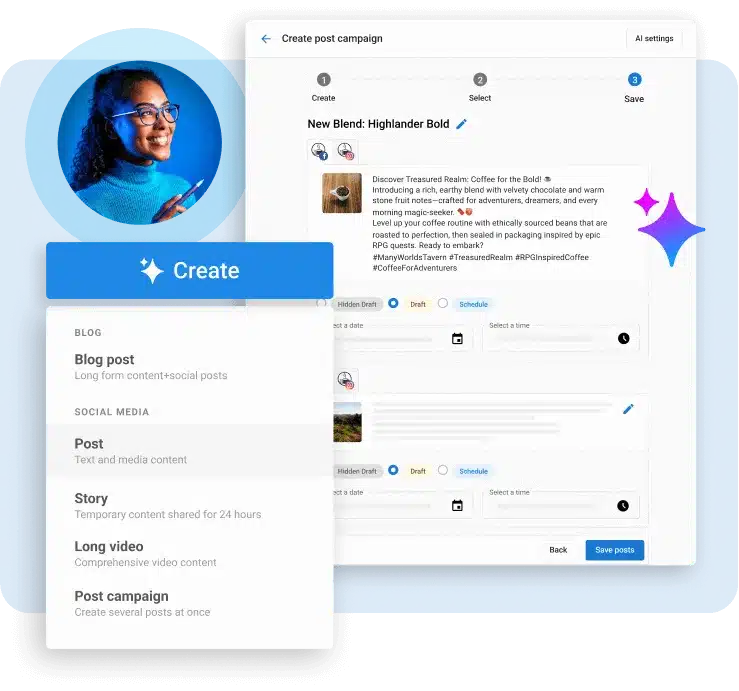
2. Automated Optimizations in Real-Time
- Instead of waiting for manual intervention, Vendasta’s AI detects and corrects inefficiencies in marketing campaigns automatically.
- AI Employees adjust bidding strategies, optimize ad placements, and refine targeting to maximize ROI.
- Example: If an ad is not converting, AI can pause it, reallocate budget, or test new variations for better results.
3. Lead Nurturing Without Manual Intervention
- AI Employees personalize outreach by sending automated follow-ups, answering inquiries, and engaging prospects in real-time.
- AI-driven messaging ensures timely responses and keeps potential clients engaged throughout the sales funnel.
- Example: If a prospect shows interest in a service but hasn’t converted, AI sends personalized reminders and offers to encourage action.
Key Benefit for Agencies:
AI employees reduce operational workload, enabling agencies to serve more clients without expanding staff. By automating repetitive tasks, agencies can focus on high-value strategy and client relationships. This enhances efficiency, profitability, and client satisfaction, making AI a powerful tool for seamless scaling.
AI-Powered Personalization: Tailored Marketing at Scale
Vendasta’s AI-driven personalization solutions enable you to deliver hyper-relevant marketing strategies tailored to small and medium-sized businesses (SMBs). You can easily automate personalization at scale, driving higher engagement, conversions, and customer retention without increasing manual effort.
1. AI-Powered Content Recommendations
- AI analyzes audience behavior and industry trends to suggest high-performing content topics, ad copy, and email sequences tailored to SMB audiences.
- You can use AI insights to create data-backed, conversion-focused campaigns.
- Example: AI might recommend seasonal promotions, trending industry topics, or customer pain points to drive engagement.
2. Customer Journey Automation
- AI maps out the customer lifecycle, identifying optimal touchpoints for engagement.
- Automates personalized outreach, targeted offers, and timely follow-ups, ensuring leads move smoothly through the sales funnel.
- Example: AI Receptionist detects when a lead engages with content but hasn’t converted and triggers a personalized follow-up email or discount offer.
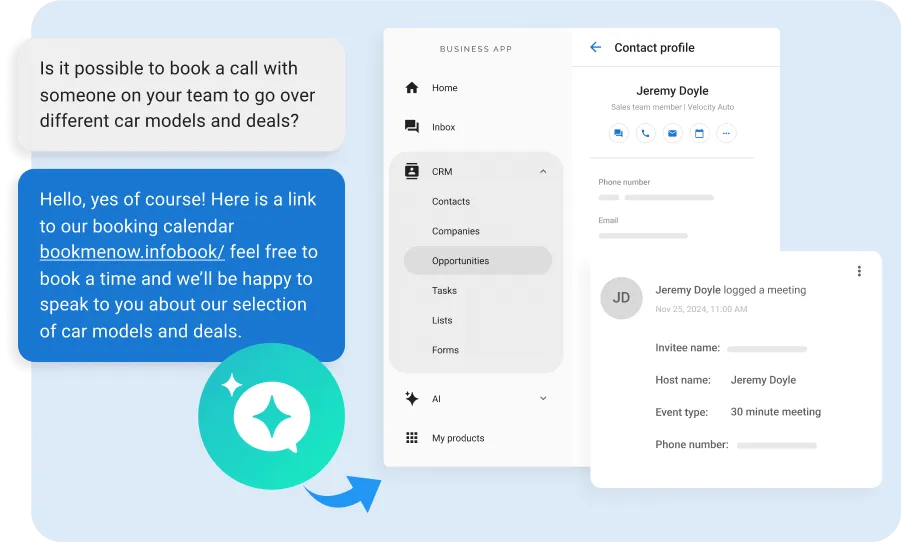
3. Predictive Customer Segmentation
- AI segments customers based on behavioral data, purchase history, and engagement patterns, ensuring each campaign targets the right audience.
- Automates A/B testing and audience refinement, allowing agencies to optimize messaging for maximum impact.
- Example: AI can separate high-intent buyers from casual browsers, adjusting marketing strategies accordingly.
Key Benefit for Agencies:
Agencies can provide SMB clients with advanced AI-powered personalization without extra manual effort. AI enables highly targeted, scalable marketing that enhances engagement, boosts conversions, and strengthens customer relationships. Automating personalization increases efficiency, reduces costs, and maximizes marketing ROI.
Smart Automation: Eliminating Repetitive Work for Agencies and SMBs
Do you struggle to manage multiple clients, platforms, and workflows and lose your opportunities? We’ve got you! Vendasta’s AI-powered automation eliminates these repetitive tasks, allowing you to focus on strategy, creativity, and client growth while AI handles the operational workload.
1. End-to-End Marketing Automation
- AI automatically schedules and publishes social media posts, blog content, and ad campaigns based on real-time engagement data.
- Optimizes PPC ads by adjusting bids, targeting, and messaging to maximize conversions.
- Personalizes email sequences by analyzing customer behavior and sending the right message at the right time.
- Example: AI identifies that a lead engaged with an email but didn’t convert—automatically triggering a follow-up email with a tailored offer.
Pro Tip: Vendasta offers full-fledged customer journey automation using AI tools and solutions. Here is an overview of the end-to-end marketing automation that helps eliminate a lot of guesswork and enables agencies to scale efficiently with minimal manual intervention.
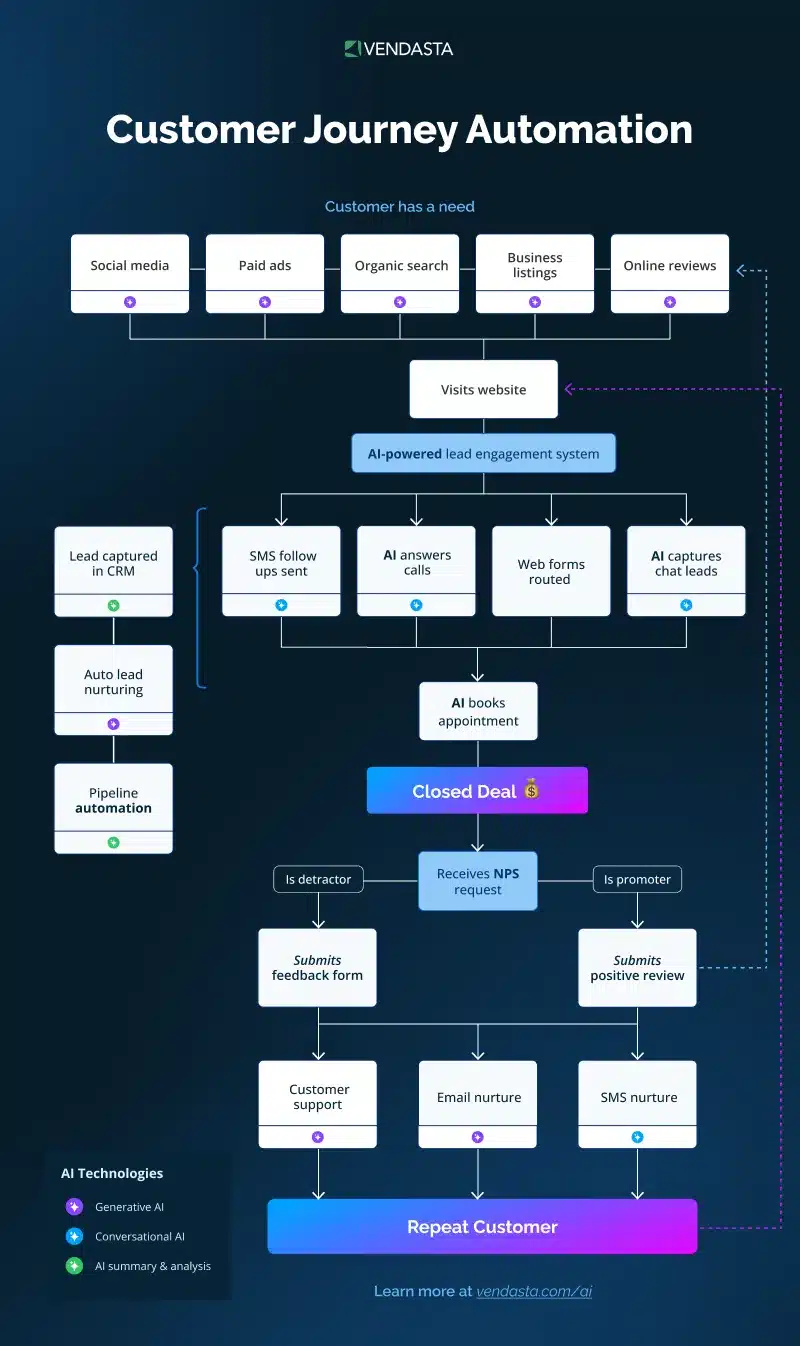
2. Sales and Lead Management Automation
- AI qualifies leads, scoring them based on their likelihood to convert, so sales teams can focus on high-value prospects.
- Automates CRM updates, follow-up emails, and lead nurturing workflows to prevent lost opportunities.
- Example: AI detects an inbound lead from a website inquiry and immediately assigns it to a sales rep, sends an automated introduction email, and schedules a follow-up.
3. Reputation Management on Autopilot
- AI Employees monitor, analyze, and respond to customer reviews across multiple platforms.
- Generates AI-powered, context-aware responses to reviews, ensuring businesses maintain a positive online reputation.
- Tracks sentiment trends, identifying potential brand perception issues before they escalate.
- Example: AI identifies a trend of negative reviews about a specific product feature, allowing businesses to address concerns proactively.
Key Benefit for Agencies:
Automating repetitive tasks saves time, reduces manual workload, and lowers operational overhead. AI enhances campaign efficiency, lead conversion, and brand reputation management without human intervention. Freed-up resources enable a stronger focus on growth, innovation, and client relationship-building.
Partner-SMB Collaboration: A Seamless Client Experience
1. Real-Time Performance Tracking
- Agencies and SMBs gain live access to campaign reports, lead generation metrics, and customer engagement data via a unified dashboard.
- AI continuously monitors marketing performance, providing real-time updates on ad spend, SEO rankings, social media engagement, and conversion rates.
- Example: An SMB owner can check ad performance insights instantly without waiting for agency reports.
2. AI-Powered Reporting and Insights
- AI automatically generates customized reports summarizing marketing performance, ROI, and customer engagement trends.
- Agencies can deliver data-driven insights without spending hours compiling analytics manually.
- Example: AI detects a drop in engagement on social media and suggests content adjustments or ad optimizations.
3. Joint Task Management for Agencies and SMBs
- AI assigns actionable tasks to both agencies and SMBs, ensuring collaborative execution and accountability.
- Agencies can track client-side actions (e.g., responding to leads or approving content) while AI automates reminders to keep projects on track.
- Example: If a campaign requires client approval, AI notifies the SMB owner and reminds them to review it, ensuring smooth workflow execution.
Key Benefit for Agencies:
Increased transparency builds trust by giving SMBs direct access to real-time marketing data, while automated AI-driven reporting saves agencies time and provides valuable insights. Joint task management ensures smooth project execution, keeping both agencies and clients engaged and accountable.
A Fully Integrated AI-Driven Marketing Platform
Many AI tools specialize in isolated functions, such as email automation, PPC management, or content generation, requiring agencies to juggle multiple disconnected platforms. Vendasta’s AI-powered platform, however, delivers a fully integrated marketing, sales, and operations ecosystem.
1. AI-Powered Marketing Automation
- Automates and optimizes multi-channel campaigns, including:
- PPC ads (AI-driven budget allocation & bidding).
- Email marketing (personalized, automated sequences).
- SEO optimization (AI-powered keyword insights & content recommendations).
- Social media scheduling & engagement (intelligent post timing & automated replies).
- Example: AI detects underperforming ads and automatically adjusts targeting and budget allocation for better ROI.
2. Sales & CRM Workflows Powered by Predictive AI Insights
- AI-enhanced lead scoring and qualification ensures that agencies focus on high-intent prospects.
- Automated follow-ups and personalized outreach optimize conversion rates.
- AI tracks customer interactions and predicts the next-best actions to close more deals.
- Example: AI identifies a lead engaging frequently with an agency’s website and automatically triggers a sales rep notification for a follow-up.
3. AI-Enhanced Billing, Reporting & Operational Tools
- Automated AI-driven reporting delivers real-time insights on campaign performance, client ROI, and customer trends—eliminating the need for manual report generation.
- Seamless billing and operational management simplifies agency workflows.
- Example: AI generates customized client reports with actionable recommendations, helping agencies prove ROI effortlessly.
Key Benefit for Agencies: A Unified AI-Powered Ecosystem
AI eliminates platform overload by consolidating multiple tools into a single, seamless solution. It reduces complexity, enhances efficiency, and streamlines operations with an all-in-one AI-driven approach. By automating repetitive tasks and optimizing campaign performance in real-time, AI increases agency profitability.
Conclusion: Embrace AI to Stay Competitive
AI is no longer just an emerging trend—it has become a fundamental necessity to help you scale operations, enhance efficiency, and drive better results. If your agency fails to integrate AI into your workflows, you risk falling behind competitors.
Take Action Today
Our AI cheat sheet highlights the best ways to start leveraging AI effectively. To stay ahead, you should start small and scale AI adoption gradually by identifying 1-2 key areas where AI can make an immediate impact:
- Automate time-consuming tasks (e.g., AI-driven content generation, ad optimization, and lead nurturing).
- Enhance personalization (e.g., AI-powered audience segmentation and predictive customer engagement).
- Improve operational efficiency (e.g., AI-assisted CRM management and automated reporting).
Why Choose Vendasta’s AI-Powered Solutions?
Vendasta simplifies AI adoption by providing a fully integrated, all-in-one AI-driven platform designed for agencies of all sizes. With marketing automation, sales intelligence, CRM enhancements, and AI-driven reporting, you can easily integrate AI into your workflows—without the complexity of managing multiple disconnected tools. Contact us to schedule a free demo today.
AI Cheat Sheet FAQs
1. What is an AI cheat sheet?
An AI cheat sheet is a quick-reference guide that explains essential artificial intelligence concepts, tools, and strategies. It helps marketers, agencies, and businesses understand how to implement AI effectively without getting lost in technical jargon.
2. Why should marketers use an AI cheat sheet?
Marketers should use an AI cheat sheet to quickly grasp AI applications like automation, personalization, and predictive analytics. It saves time by breaking down complex ideas into actionable steps, allowing you to implement AI tools faster and stay ahead of competitors.
3. How does an AI cheat sheet help agencies?
An AI cheat sheet gives agencies a structured way to integrate AI into client strategies. From content creation to ad optimization, it outlines where AI provides the most ROI. Vendasta enhances this by offering ready-to-deploy AI tools built for agencies managing multiple SMB clients.
4. What should be included in an AI cheat sheet?
An AI cheat sheet should include definitions of key terms, examples of AI in action, recommended tools, and implementation steps. It should also highlight best practices and potential pitfalls, helping businesses apply AI confidently in their marketing strategy.
5. Is an AI cheat sheet useful for beginners?
Yes, an AI cheat sheet is designed to simplify complex concepts for beginners. It provides quick explanations and practical use cases so you can start leveraging AI without needing a technical background.
6. Can I implement AI without technical expertise?
Yes, many AI tools are designed for non-technical users. An AI cheat sheet helps you choose tools that automate processes like content generation, ad targeting, and reporting. Vendasta’s platform makes AI adoption seamless by integrating everything into one platform.
7. How does an AI cheat sheet improve marketing ROI?
By highlighting the most effective AI use cases, a cheat sheet prevents wasted effort on unnecessary tools. When applied correctly, AI improves efficiency, enhances personalization, and drives higher conversions—directly boosting marketing ROI.
8. Do agencies really need an AI cheat sheet in 2025?
Yes. With AI adoption accelerating, agencies risk falling behind without a clear strategy. An AI cheat sheet gives step-by-step guidance to stay competitive. Vendasta partners can go further by turning AI-powered efficiency into a revenue-generating advantage.
9. What are some examples of AI in a cheat sheet?
Examples often include chatbots for customer service, predictive analytics for lead scoring, AI-generated content, automated ad bidding, and sentiment analysis. Vendasta includes these and more, providing a unified toolkit for agencies serving SMBs.
10. Can AI cheat sheets help small businesses too?
Absolutely. Small businesses benefit from simplified AI guidance as well. A well-structured cheat sheet empowers SMBs to automate marketing, improve customer engagement, and save time without overwhelming resources.
11. Is an AI cheat sheet just for marketing?
No, AI cheat sheets can cover many industries, but marketing-focused ones are especially valuable. They guide agencies and SMBs in applying AI for automation, personalization, SEO, and customer engagement.
12. What’s the difference between an AI cheat sheet and an AI playbook?
An AI cheat sheet is a quick-reference guide with concise information, while an AI playbook is more detailed, outlining strategies and processes. Many agencies use both—cheat sheets for fast decisions, and playbooks for deeper implementation.

